Better Sailing
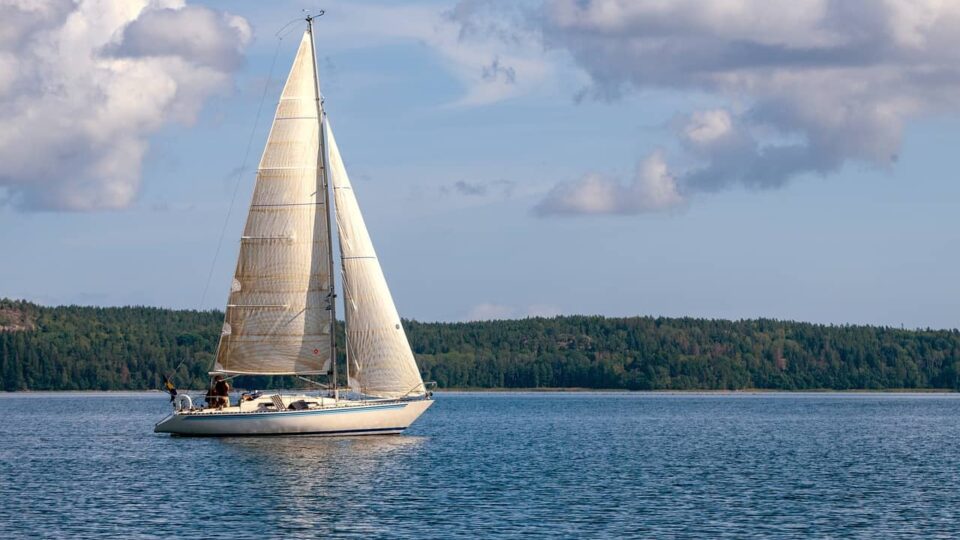

Best Small Sailboats To Sail Around The World
While there are plenty of 30-35ft blue water cruising yachts currently on the used sailboat market, many of them are tired and need new standing rigging, sails, engine, etc. That said, there are good boats out there that have been loved and looked after. Those that are well used have most likely been well maintained, too, so don’t be put off by yachts that have crossed oceans or even circumnavigated before, as their owners will have had to keep them properly seaworthy. Sailing around the world is no easy task, so these boats should be in tip-top shape.
Some might consider 30-35ft too small for bluewater cruising or for a circumnavigation (sail around the world), but that has been disproved over the years. Bigger might be better for coastal cruising with friends, but maintenance costs rise exponentially with every extra foot. A small sailboat should be more than enough to carry a couple off on the adventures of which they dream.
Nicholson 35
Now somewhat legendary, the tough and dependable Nicholson 35 first appeared in 1971, and between then and 1985, some 228 boats were launched. Built to Lloyds’ specifications with a hand-laid solid GRP hull, she boasts a fully encapsulated lead fin keel and full-depth skeg. She has an alluring sheer with nicely balanced overhangs, giving her bows a powerful go-anywhere look, while her low-profile coachroof blends pleasingly into the decks.
Compared to today’s modern cruiser, the Nic 35’s accommodation is somewhat limited due to her relatively narrow beam and pinched ends, but what there is has been used intelligently and makes for a good working environment on long passages. The need to pass through the heads to reach the forecabin can be inconvenient with guests on board. Still, for two people cruising, these minor irritations are more than compensated for with the high quality and solidity of the fittings and joinery and the availability of safe sea berths on passage.
The main saloon is comfortable with 1.88m/6ft 2in headroom. A U-shaped dinette makes a narrow but long double in port, and the 1.92m/6ft 4in-long starboard settee a great sea berth. However, many were fitted with one or two pilot berths above the settee backs instead of lockers. The galley boasts a huge coolbox, full-size gimballed cooker, deep sink, and plenty of stowage. A crash bar, bum strap, and bulkhead pole make it a great working galley at sea. Opposite is a large aft-facing chart table with instrument mounting space on a half bulkhead separating it from the watch seat and wet locker further aft. A few boats had a forward-facing chart table and roomy quarter berth instead.
The water tanks are under the sole above the keel, not under the saloon settees as with many modern crafts. Small portlights and hatches mean natural light and ventilation might not be so plentiful as on a newer boat, but then there is less opportunity for leaks. Her cockpit is business-like – not over wide but with high coamings to support the crew securely and keep them dry. She also has a high bridge deck to stop water going below should a wave find its way into the cockpit and very deep cockpit lockers. The mainsheet track is within reach of the helmsman, just forward of the pedestal, but getting to the primaries entails climbing over the seats from behind the wheel. Her masthead sloop rig has a keelstepped mast. It is stout and uncomplicated, with twin lower shrouds and a removable inner forestay for a storm jib.
Post-1975 models had a taller mast option (51ft as opposed to 45ft), increasing the sail area considerably. No doubt most will now have the control lines led aft into the cockpit for safer shorthanded sailing. Under sail, the Nic comes into her own. She has a very positive helm, although she can be prone to weather helm if overpressed. Her performance under sail is well mannered and drama free. However, her large (145%) genoa can take some sheeting in (don’t leave the inner forestay on). Her high bows part the waves with a gentle motion, and her deep, longish keel keeps her tracking dead straight in a following sea. She won’t break any speed records, averaging around 5 knots on a long passage, but she’ll always get you there safely and in comfort.
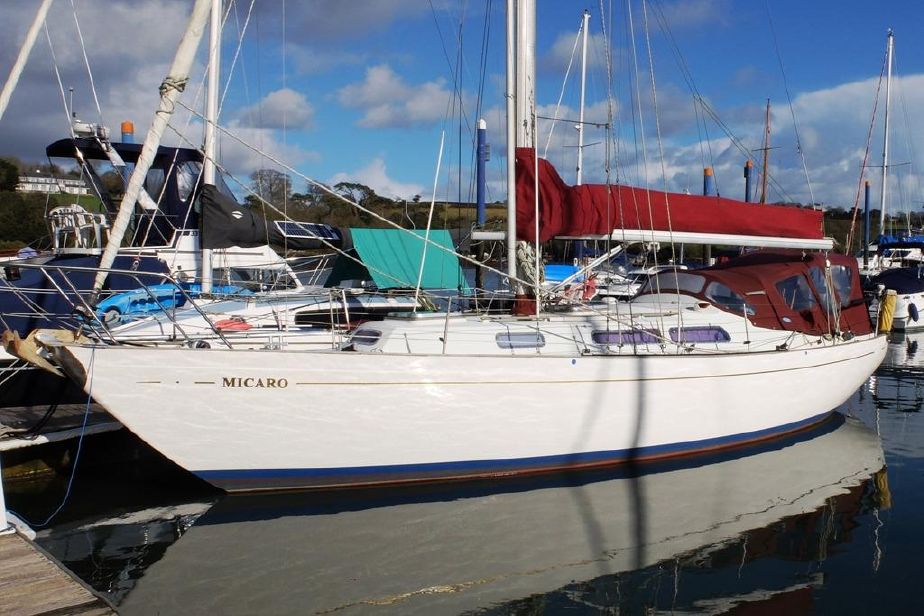
Nicholson 35 Specs
>>Also Read: Best Sailboats Under 30 Feet
The Sadler 34 evolved from the 32, and while the 32 was a tough, capable seaworthy sailboat cable of sailing around the world. The 34 offers much more in the way of accommodation thanks to her wider beam. Apart from being pretty, the most notable feature of the 34 is her double-skinned hull, sandwiched with thick closed-cell foam, making her unsinkable and eliminating condensation thanks to the added insulation. She came with a deep fin, shoal fin, or bilge keels, and the post-1990 models had a Stephen Jones-designed, foiled fin keel with ballast bulb that upped upwind performance. Under sail, she is responsive and vice free with a comfy motion and predictable handling. While her pinched (in modern terms) stern might limit the width of the aft cabin, it works well at sea, allowing her deep full skeg-hung rudder to keep a good bite on the water.
The Sadler 34 is quite a powerful performer and, despite having a fairly high displacement, achieves excellent passage times due to her ability to soldier on through foul weather and rough seas. Her deep and secure cockpit is perfectly dimensioned so as not to get thrown around at sea, and yet it provides enough clear seating for dining alfresco with mates. Stowage is also good, especially in the full-depth locker to port. There are harness points in the cockpit, but the mainsheet track runs across the bridge deck, which can catch out the unwary if the traveler isn’t locked in place.
On deck, the layout is practical, and the side decks uncluttered. Her foredeck is set up ideally for regular anchoring with a twin roller stemhead fitting and big anchor locker. Her accommodation is spacious enough for four. Though it was called a ‘double’ aft cabin, it only really works as a single, roomy quarterberth. She has an excellent U-shaped galley where pretty much everything can be reached with ease. The chart table opposite faces forward with its own seat, and there’s room aplenty for instruments and pilot books. Her saloon is roomy, and the table and seating are large enough for six to dine in comfort.
To port, the heads have a basin and its own door, allowing access to the forecabin. But in shower mode, the entire compartment runs athwartships, which isn’t ideal, especially as the hanging locker is in the same enclosure. There’s a decent-sized vee berth forward, which makes an ideal owner’s cabin at anchor. Stowage is reasonable, although the water tank is under the starboard settee.
Sadler 34 Specs
>>Also Read: Best Sailboats Under 100k
Not unlike the Nicholson 35 in both hull lines and reputation, the Rival 36 is a tough, solid yacht designed for passagemaking in virtually all weathers and sea conditions. The 36 slotted between the slightly cramped 34 and the larger 38 ketch, with 78 in total being launched. Possibly a squeeze on such a tight budget, but you get a lot more space in the R36 than the older R34, and there’s a good chance you could find one that’s already equipped for bluewater cruising. She was offered as a masthead sloop or with a cutter rig option. Keel choice was between a deep lead-ballasted fin, a shallower Scheel keel, or a centerboard (R36C).
Under sail, she’s predictable and easily handled, although, like her predecessors, she’s not the fastest boat around. As with most heavy displacement cruisers, she’s designed more to get you safely across oceans than to race around the cans. Wheel or tiller-steered, she has a large, deep cockpit with high coamings and excellent stowage for deck gear. Access along the wide side decks is good, assisted One of a range of solidly built and well-found cruising yachts built by Northshore Yachts, the Vancouver 32 was designed specifically for serious passagemaking.
Full hull sections and short overhangs offer a high-volume yacht with excellent load-carrying abilities. Her fully encapsulated shallow keel contains nearly 3 tonnes of lead ballast, giving her an enviable ballast ratio of nearly 45%; a keel shoe extends aft to support the rudder and protect the prop from floating debris and lines. Only available with tiller steering and transom-hung rudder, she has an easily manageable masthead cutter rig with full shrouds and twin straight spreaders.
A smart teak-capped bulwark offers extra security going forward while large scuppers ensure rapid deck drainage. The interior is surprisingly spacious and comfy. The long quarterberth and port-side straight by high teak-capped gunwales and long handrails on the coachroof, and the foredeck big enough for handling the headsails and ground tackle, which can be securely stowed in the large, deep anchor locker when sailing. Below decks, she is warm and woody and retains the trademark Rival ‘keyhole’ bulkhead separating the superbly designed and well-appointed galley and navigation areas from the saloon. The twin-leaf saloon table has fiddles and can seat six for a meal, while the settees are straight and make comfortable 1.91m-long sea berths with lee cloths. Most had a pipe cot above as well.
Maximum headroom is 1.91m/6ft 3in, and stowage is good, thanks in part to the water tank being above the keel. With no double cabin aft and only a quarterberth, the forecabin provides a comfortable vee berth with ample floor space to dress, plenty of lockers to stow your clothing, and even a dressing table. The heads/shower compartment is also roomy, and Jack and Jill doors offer access from both saloon and forecabin.

Rival 36 Specs
>>Also Read: Best Sailboat Brands
Vancouver 32
One of a range of solidly built and well-found cruising yachts built by Northshore Yachts, the Vancouver 32 was designed specifically for serious passage making. Full hull sections and short overhangs offer a high-volume yacht with excellent load-carrying abilities. Her fully encapsulated shallow keel contains nearly 3 tonnes of lead ballast, giving her an enviable ballast ratio of nearly 45%; a keel shoe extends aft to support the rudder and protect the prop from floating debris and lines. Only available with tiller steering and transom-hung rudder, she has an easily manageable masthead cutter rig with full shrouds and twin straight spreaders. A smart teak-capped bulwark offers extra security going forward while large scuppers ensure rapid deck drainage. The interior is surprisingly spacious and comfy.
The long quarterberth and port-side straight settees make excellent sea berths, leaving the U-shaped starboard saloon settee (converts into double berth) and roomy vee berth forward for sleeping at anchor. A half bulkhead separates the galley/navigation areas from the saloon, with a support pillar on either side providing excellent handgrips. It’s a bonus having the quarter berths behind the ch
art table as it allows the off-watch crew to keep one eye on the instruments and chart. However, having the heads forward can result in a lot of water dripping off your oilies when going below in wet weather.
All that lovely solid hardwood adds to her weight (nearly twice that of a modern 32ft Bavaria). Most owners are more concerned with her superb oceangoing abilities, though. She sails predictably and undramatically, her high bows and fine balance ensuring she parts the waves with little spray and no slamming – ideal for long passages where many lighter boats can throw you about.

Vancouver 32 Specs
Peter is the editor of Better Sailing. He has sailed for countless hours and has maintained his own boats and sailboats for years. After years of trial and error, he decided to start this website to share the knowledge.
Related Posts

The Ultimate Guide to Choosing the Best Fishing Line for Trolling

Lagoon Catamaran Review: Are Lagoon Catamarans Good?

Best Inboard Boat Engine Brands

Are O’Day Sailboats Good? A Closer Look at a Classic Brand
- Buyer's Guide
- Destinations
- Maintenance
- Sailing Info
Hit enter to search or ESC to close.

Szymon Kuczynski World Record for the Smallest Yacht around the Globe Solo and Non-Stop

Szymon Kuczynski secured a new world record for the smallest yacht to circumnavigate the globe singlehanded and unaided, when he returned to Mayflower Marina in Plymouth on Thursday 17th May.
Szymon, who set sail last year from Plymouth on August 19, completed the circumnavigation in 270 days, 10 hours and 29 minute. The World Sailing Speed Record Council recognizes a similar feat by Alessandro di Benedetto (FRA/ITA) in 2009-10 who sailed a 6.5m (21ft 3.9in) Mini yacht around the world in 268 days, 19 hours, 36 minutes, 12 seconds.
The solo sailor took a classic route round the three famous capes of Africa, Australia and South America . Szymon had been living in a space of just four square metres for over 9 months and accomplished this trip without ever making any stops to ports.
In 2013, he sailed back and forward across the Atlantic Ocean on his self-built, 5m long yacht, “Lilla My” as part of a ‘Call to the Ocean’ race.
And in 2014, Szymon finished his round the world trip- “Maxus Solo Around”- taking the Pasat Route, making stops at ports along the way.

About the boat
The sailboat was manufactured in the Northman shipyard in Poland. The Maxus 22, which is normally used for in-land sailing and close-shore waters, has been adjusted for such and ocean challenge, by changing most of it’s construction.
The hull and rigging have been strengthened and the interior of the yacht has been limited to the essential appliances. The cabin can be hermetically closed, and the hull can still remain floating on the water, even in case of an accident and a complete water flooding inside.
Szymon Kuczynski Journey Statistics
Time: 270 days, 10 hours, 29 minutes. Miles travelled: 29 044. Average speed: 4,5 kt. Maximum speed: 14,9 kt. Books read: 143.
Uncharted Waters: Krystyna Chojnowska-Liskiewicz’s Solo Voyage Around the World
7 bluewater cruising sailboats we love, come sail away: 4 stories about sailing, sailing nandji ep 347 water damaged boat now ocean ready, live your passion, subscribe to our mailing list, one comment.
How could you leave out the most important part of the news. Here it is: 6,36 m.

Service Locator
- Angler Endorsement
- Boat Towing Coverage
- Mechanical Breakdown
- Insurance Requirements in Mexico
- Agreed Hull Value
- Actual Cash Value
- Liability Only
- Insurance Payment Options
- Claims Information
- Towing Service Agreement
- Membership Plans
- Boat Show Tickets
- BoatUS Boats For Sale
- Membership Payment Options
- Consumer Affairs
- Boat Documentation Requirements
- Installation Instructions
- Shipping & Handling Information
- Contact Boat Lettering
- End User Agreement
- Frequently Asked Questions
- Vessel Documentation
- BoatUS Foundation
- Government Affairs
- Powercruisers
- Buying & Selling Advice
- Maintenance
- Tow Vehicles
- Make & Create
- Makeovers & Refitting
- Accessories
- Electronics
- Skills, Tips, Tools
- Spring Preparation
- Winterization
- Boaters’ Rights
- Environment & Clean Water
- Boat Safety
- Navigational Hazards
- Personal Safety
- Batteries & Onboard Power
- Motors, Engines, Propulsion
- Best Day on the Water
- Books & Movies
- Communication & Etiquette
- Contests & Sweepstakes
- Colleges & Tech Schools
- Food, Drink, Entertainment
- New To Boating
- Travel & Destinations
- Watersports
- Anchors & Anchoring
- Boat Handling
Around the World Solo in a 21-Footer
Advertisement
Over more than 9 months, and 29,000 miles at sea, Polish sailor Szymon Kuczynski sailed alone and unaided around the world.
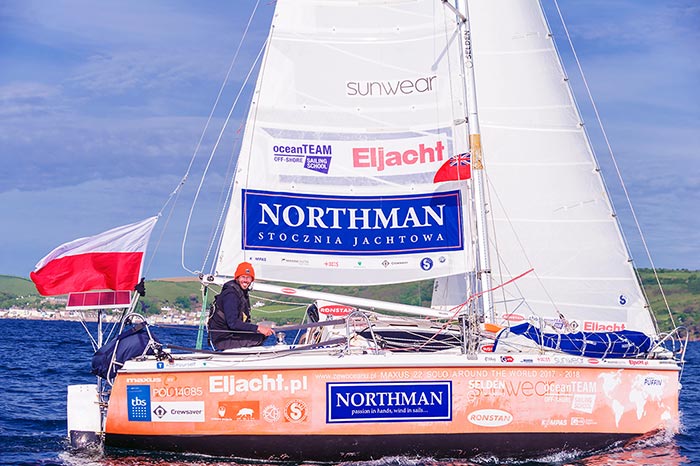
As our editors send you this story, about an extraordinary man who has just sailed around the world solo in a small boat, another group of the world's top sailors has just finished a similar circumnavigation in the grand prix Volvo Ocean Race. It was a dramatic photo finish upset for the Volvo, the closest win in 45 years, and a stunning display of navigational and weather-routing virtuosity. Stay tuned. We're working on a story of the highlights for you that will be in our next edition. This month, though, we give you a bit of perspective on such feats, and introduce you to an around-the-world dreamer who quietly accomplished a quest just as epic.
The next time you think your boat's a little too small, remember the story of Szymon Kuczynski, 37, who just spent more that 270 days sailing 29,000 nautical miles around the world in a boat less than 21 feet. That's a new world record for the smallest yacht to circumnavigate the globe non-stop with no engine. For perspective, less than 300 people are known to have sailed single-handed around the world — only 80 have done so without stopovers or assistance.
The sailboat, a Maxus 22, was manufactured in the Northman shipyard in Poland. The boat, which is designed for in-land and close-shore sailing, was extensively modified and strengthened for the ocean challenge. The modification included tightly sealing his cabin, which he said challenged his morale with high temperatures and poor air circulation. He lamented to a friend that his precious supply of chocolates had melted and had to be cast overboard. The normally mobile and energetic Polish national made the best of his months alone in tight quarters by reportedly reading his way through 143 books.
Kuczynski struggled to wring out boat speed, changing sails seven or eight times per day , which was complicated by the additional shrouds required to support the mast, and the lower than normal boom position, both modifications made to upgrade the rig prior to the start of the voyage.
The boat averaged 4.5 knots for the voyage, with a top speed of 14.9 knots. Kuczynski, a seasoned sailor, instructor and lecturer, largely self-funded his latest voyage with the help of several logistical sponsors. He followed in the footsteps of famous seafarers who set sail from Plymouth to circumnavigate the globe, including Sir Francis Chichester and Sir Francis Drake.
"I am honored to be one of them," he wrote in the last miles of his journey. "It was a very special moment to see Plymouth on the horizon as I completed by world record attempt, it felt like coming home. It has been an amazing experience."
Related Articles
The truth about ceramic coatings for boats.
Our editor investigates the marketing claims of consumer-grade ceramic coatings.
Fine-Tune Your Side Scan Fishfinder
Take your side-scanning fishfinder off auto mode, and you’ll be spotting your prey from afar in no time
DIY Boat Foam Decking
Closed-cell foam flooring helps make boating more comfortable. Here’s how to install it on your vessel
Click to explore related articles
Contributing Editor, BoatUS Magazine
A marine surveyor and holder of RYA Yachtmaster Ocean certification, BoatUS Magazine contributing editor Mark Corke is one of our DIY gurus, creating easy-to-follow how-to articles and videos. Mark has built five boats himself (both power and sail), has been an experienced editor at several top boating magazines (including former associate editor of BoatUS Magazine), worked for the BBC, written four DIY books, skippered two round-the-world yachts, and holds the Guinness World Record for the fastest there-and-back crossing of the English Channel — in a kayak! He and his wife have a Grand Banks 32.
BoatUS Magazine Is A Benefit Of BoatUS Membership
Membership Benefits Include:
Subscription to the print version of BoatUS Magazine
4% back on purchases from West Marine stores or online at WestMarine.com
Discounts on fuel, transient slips, repairs and more at over 1,200 businesses
Deals on cruises, charters, car rentals, hotel stays and more…
All for only $25/year!
We use cookies to enhance your visit to our website and to improve your experience. By continuing to use our website, you’re agreeing to our cookie policy.
Yachting World
- Digital Edition

Smallest boats: The bonkers world of Microyacht adventures
- Elaine Bunting
- November 28, 2022
What are the smallest boats sailors consider for crossing and ocean? For ‘microyacht’ voyagers, there's no limit. Elaine Bunting finds out why they put to sea in tiny vessels

Often the smallest boats to cross oceans look much like a child’s crayon picture of a little boat on a big sea, certainly Yann Quenet’s Baluchon does. Baluchon is only 13ft 1in (4m long), with one simple sail and a stubby, blunt-nosed hull painted cherry red and ice cream white.
Baluchon is no toy, though. When Quenet sailed it back to Brittany in August, he had fulfilled his childhood ambition of circumnavigating in a tiny boat. Its simple appearance is emblematic of his philosophy. “I have loved little boats since I was a child,” he says, “and I am still a child at heart. Sailing round the world on a little boat is something I have dreamed about since I was a teenager.”
Quenet, now 51, has dedicated much of his adult life to designing, building and sailing microyachts. Whereas most of us progress in incrementally larger boats, Quenet’s craft have always been minuscule. He has created numerous self-build designs for plywood construction from a 9m gaffer to a 5m trimaran and a 6.5m gaff yawl (see them at boat-et-koad.com ).
In 2015, Quenet attempted to cross the Atlantic in a 14ft 1in (4.3m) plywood scow, but it capsized in a storm off the coast of Spain and he was rescued by a ship. After that experience he resolved to come up with a bulletproof self-righting microyacht suitable for ocean sailing, and went back to the drawing board.
His solution was a pram-style design that could be built in plywood in under 4,000 hours and would cost no more than €4,000. Baluchon is the result, a tiny boat to be sailed by one person for up to six weeks at a time and resilient enough to take anything the oceans throw at it.

Yann Quenet’s 4m long Baluchon
Smallest boats getting smaller
The history of sailing across oceans in the smallest boats is a surprisingly long one. With a few exceptions (of which more later), it is not about breaking records. This is about stripping away everything complex and extraneous – including other people.
One of the most famous small boat voyages was nearly 70 years ago when Patrick Elam and Colin Mudie made several ocean passages in Sopranino , which was only 17ft 9in (5.4m) on the waterline. Elam observed: “I would not pretend that Sopranino is the optimum size. At sea she is near perfect, but could with advantage be a few inches longer to give a slightly bigger cockpit and a separate stowage for wet oilskins below. In harbour, she is too small (for comfort) and too delicate and vulnerable.”
Also in the 1950s, John Guzzwell consulted Jack Giles about the smallest boat practical to sail around the world and Giles drew the 20ft 6in (6.2m) Trekka , which Guzzwell built and circumnavigated in twice. Smaller still was Shane Acton’s 18ft 4in (5.5m) Shrimpy , a Robert Tucker design which he sailed round the world in 1972 despite having very little sailing experience when he left.

Tom McNally planned to retake his small-boat Atlantic crossing record in Big C. Photo: Ajax News
In 1987, Serge Testa beat that by sailing round the world in his self-designed 11ft 10in (3.6m) aluminium sloop, Acrohc Australis . He broke the record for the smallest yacht to be sailed round the world, one that is still standing 35 years later.
This feat, together with Acton’s well-publicised voyages in the 1970s, ignited a lasting interest in small boat or microyacht voyages. Money is usually a factor in the choice of such small craft but overlaid by a streak of determined romanticism, the almost spiritual challenge of sailing a nutshell craft across a vast ocean.
Yann Quenet is not alone in creating self-build plans for aspiring micro-voyagers. New Zealander John Welsford also specialises in small boats such as the 18ft (5.5m) junk-rigged Swaggie – ‘a mighty, miniature long range cruiser’ – and a sturdy oceangoing 21ft (6.5m) gaff cutter, Sundowner (see jwboatdesigns.co.nz ).
As with Quenet’s little boats, Welsford’s designs are for plywood construction. The plans, he says, are detailed for “real beginners with very basic woodworking skills and a good attitude… the other skills will come as the project progresses.”
In his thinking, people can experience a deep sense of escape even through the process of building such a boat. “I anticipate a lot of builders will be people who find themselves trapped in a soulless desk job which condemns them to commuting for hours in heavy traffic, living in a thin-walled and crowded apartment and dreaming with longing of the freedom of the seas, golden sands and warm breezes.”

John Guzzwell’s Trekka. Photo: Historic Images/Alamy
Perhaps unsurprisingly the small boat community attracts a mixture of adventurers, inventors, idealists and eccentrics. One of the less successful was the self-styled ‘Admiral Dinghy’, a former Hollywood B-movie star and retired dance teacher from the US whose longtime aim was to sail round the world in a 9ft 11in (3m) boat. He had scant ocean sailing experience and no money. He’d been building and tinkering with his tiny junk-rigged boat since 1975 and began preparing for a circumnavigation in earnest in 2009. But he had problems with his boat, never went offshore and has since vanished from the radar.
A small boat living legend
A mixture of naïve courage and inexperience appears characteristic of many of the smallest boat sailors. It’s easy to imagine a dichotomy at the heart of it: many of the ideas could be perilous in hands of someone inexperienced, yet how many seasoned sailors would contemplate voyaging in a tiny craft?
Someone who has, numerous times, is Sven Yrvind. A Swedish sailor and boatbuilder, now aged 83, he has been designing and sailing tiny yachts for more than 60 years. He built his first tiny open boat in 1962, and decades of experimentation and voyaging followed.
In 1969, he built a 15ft 7in (4.2m) boat and sailed to Ireland. In 1971, he built his first Bris (or Breeze) in his mother’s basement, its size dictated by the dimensions of the cellar and the door it would have to be taken out through. He sailed this 19ft 8in (6m) cold moulded epoxy double-ender across the Atlantic seven times in four years and went as far as Argentina and Tristan da Cunha. (I highly recommend reading his fascinating and entertaining account at yrvind.com/my-life-texts ).

Yann Quenet completed a three-year world tour on his 4m Baluchon. Photo: Damien Meyer/AFP/Getty
In his next boat, the 15ft 9in (5.9m) Bris II , he went much further, sailing south to the Falkland Islands in 1980, before rounding Cape Horn and going north to Chile.
Over the decades, Yrvind (his birth surname was Lundin but he changed it to the Swedish term for a turbulent wind) has continually experimented with tiny yachts. In 1986, he built a 15ft 8in (5.76m) double-ender and sailed it to Newfoundland. In his most recent boat, Exlex (Outlaw), he sailed to the Azores in 2018, and in 2020 from Norway to the Azores and Madeira, returning to Ireland, a voyage of 150 days.
Right now, he is working on Exlex Minor , a glassfibre sailing canoe design of 20ft 4in (6.2m) which he intends to sail round Cape Horn to Valdivia in Chile. This new boat has twin keels and 12m2 of canvas split between three square sails on freestanding masts.
His food, water and all his possessions for up to 150 days at sea amount to around 1 tonne. He stores 111 litres of water on board as he “doesn’t trust desalinators. They can break down.” At sea, his diet is a simple mix of oatmeal and almond flour – “like muesli” – and sardines. “I eat the same every day,” he says, “and at lunchtime, not any other time.”
“I am a health nut. I believe in running and eating once a day for a long life.”

small-boat sailing legend Sven Yrvind. Photo: Jonathan Nackstrand/AFP/Getty
Yrvind’s way of life divides opinion. Many casual followers think his choice of yacht slightly mad, but the tiny boat community reveres him as a living legend. To him, it just makes plain sense. “My boats are very functional. If you go back to old magazines from the 1950s and 1960s, boats were not much bigger. Back then, a 30ft boat was quite a decent size. The Hiscocks sailed twice round the world in such a boat. Now 40ft is too small; it must be 50ft.
“And what is big enough? With a small boat, you don’t have a lot of problems with money. You go back to first principles. You also have a boat you can tow behind a car. I have been doing that down to France and Ireland. Or you can put it in a container. So small boats are really handy.”

Yrvind in his 15ft 8in Exlex. Photo: Jonathan Nackstrand/AFP/Getty
No room to stretch out
Smaller even than Sven Yrvind’s vessels are the record breakers’ boats, no bigger than a bathtub.
For many years, the record for the smallest yacht to cross the Atlantic was held by Hugo Vihlen, a former Korean War fighter pilot and Delta Airlines captain from Florida. In 1968, he crossed from west to east in the 5ft 11in April Fool . In 1993, his record was broken by Tom McNally, a fine arts lecturer from Liverpool, in his 5ft 4 1/2in (1.6m) Vera Hugh .
That prompted Vihlen, then aged 61, to go back out a few months later to recapture his record in Father’s Day , which was half an inch shorter than Vera Hugh . Vihlen crossed from Newfoundland to Falmouth in 105 days.

Andrew Bedwell intends to take former record holder Tom McNally’s modified 1.1m Big C to a new Atlantic record. Photo: Paul Larkin Photography
Not to be outdone, McNally designed and built an even smaller boat for the record, the 3ft 10in (1.1m) Big C . His plans were shattered when he was diagnosed with kidney cancer and he was unable to sail it before he died in 2017.
Next year, British sailor Andrew Bedwell hopes to break Vihlen’s 30-year record. As a sailmaker and experienced sailor, he knows exactly what he is getting into. Bedwell has previously sailed a Mini 6.50 to the Arctic and been round Britain in a Class 40 .
In 2018 he started reading up about small boats. “I had always had an interest in unusual challenges and things that were raw. I saw these boats and was amazed by them, and I started designing a vessel.”
He contacted Tom McNally’s daughter and was amazed to learn that Big C was still lying in her garden. “It had never been in the water, or fitted out. Sails had been made for it, but they had never been used.”
Lorraine McNally agreed to sell, and Bedwell worked out how he could modify it for him to sail across the Atlantic. He calculates that it will take him around 60-80 days to cover the 1,900 miles from Newfoundland to the Lizard, sailing at an average of 2.5 knots. It has twin headsails set on one furler, and external floats, or pods, that make it behave a little like a trimaran when heeled. Freeboard is only 35cm and “she really does bob like a cork”, Bedwell says.
The boat is so tiny he cannot stretch out in it. “When in there I have to sit. It is dead flat in the bottom and in calm conditions I can just about get into a foetal position – and I mean just. I’ve modified the hull so my hip can just fit into a recess.”

Big C is a tight squeeze for British sailor Andrew Bedwell, and he could spend up to 80 days in it crossing the Atlantic from Newfoundland to the Lizard.
With the hatch fully shut the boat is watertight and airtight, but has only 40 minutes’ worth of air, so Bedwell is making two rotating air scoops at the bow.
When conditions allow, he might be able to stand up, or even go for a swim, but mainly “there is very little you can do with the lower body at all.”
Muscle wastage will be a major issue. To offset this at least partially, Bedwell will use a manual desalinator to make water. “We looked at putting in a generator to pedal but there isn’t space.”
His rationed food will amount to only 1,000 calories a day, “so I will lose weight and muscle mass, but I want a slow, slow decline.”
The food will all be the same. “It is a protein food similar to Shackleton’s pemmican, a clever nutritional bar made of fat and protein, salt and honey, with a little bit of paracetamol to thin the blood and ascorbic acid to preserve it and prevent scurvy,” he explains. “I will eat that for at least a month before I go, to get used to it.”
All 12 of the boat’s watertight compartments will be filled with it. “It will be moulded in bags and pushed into the hull. I will take food from the external pods to start with and work inwards, so increasing stability as we go.”

Italian skipper Alessandro Di Benedetto returns to Les Sables d’Olonne in 2010 after a non-stop circumnavigation with his 21ft Mini Transat 6.50. Photo: Charly Triballeau/AFP/Getty
Bedwell’s planning sounds scrupulous. But… isn’t it the definition of suffering?
“Yes, very close to it,” he replies cheerfully. “If you said you were going to do this to prisoners, you wouldn’t be allowed to, it’d be against human rights.
“There’s not going to be any comfort in it whatsoever. Food and navigation equipment are the absolute keys. There’ll be no changes of clothes, for example, as there’s no room. It’s so tight. I can use some water to wash but it will be a flannel wash. l’ll do what I can to prevent saltwater sores but there’s not going to be any soap.”
When close to the finish of one of his voyages, Tom McNally was hit by a ferry. The hull of his boat split and he had to be fished out of the water almost by the seat of his pants. Bedwell says: “If I’m hit by a tanker I’m not going to survive that, but tech has changed. Tom didn’t have AIS but we have a standalone Class B transponder as well as a VHF with AIS receiver . I have a masthead light – the boat is so short it doesn’t need to be a tricolour.”
Bedwell says: “Planning this keeps your mind completely occupied as every single little detail has to be completely thought through.” He rejects any suggestion that he is ‘making a bid’ for the record or similar phraseology. “I am not attempting it. I’m doing it. My theory is if I’m just trying, I’m not really pushing myself.”

Matt Kent’s 2017 solo Atlantic crossing attempt in the 42in Undaunted ended in failure.
Smallest boats, smallest problems
The micro-voyagers seem to share a different way of looking at the world, a can-do attitude galvanised by their repudiations.
“Human beings are very adaptable,” says Sven Yrvind. “Lawrence of Arabia lived simply in the desert and said wine takes away the taste of water. It is the same with comfort. It depends on your mindset and how you think, how you look at life. Some people go on holiday on bicycles and put up a tent. Some want a car and a caravan. I think when they get back the man with the bicycle is happier and has more to think about.”
“You can get spoilt,” he argues. “If you get something without fighting for it, you’re not so happy when you get it.”
Returning after 31,000 miles and 360 days under sail in his little yacht, Yann Quenet insists that a small boat is the best. “Small boat equals small problems. When there is no engine, there is nothing to go wrong, just a simple boat that is simple to sail.”
Andrew Bedwell explains how he gradually dismissed fripperies. “I’d had plusher boats, but hated it – all the cushions and wiring hidden behind panels. It’s just not me. I kept coming back to the simple things.” Like Sven Yrvind and Yann Quenet, he made the realisation that his sense of achievement might be in inverse proportion to boat size.
When people ask now about what he is doing with Big C , he tells them, without a hint of irony: “Everyone is different. I need something really big.”
If you enjoyed this….
Yachting World is the world’s leading magazine for bluewater cruisers and offshore sailors. Every month we have inspirational adventures and practical features to help you realise your sailing dreams. Build your knowledge with a subscription delivered to your door. See our latest offers and save at least 30% off the cover price.
Great choice! Your favorites are temporarily saved for this session. Sign in to save them permanently, access them on any device, and receive relevant alerts.
- Sailboat Guide

- Collections
Twenty Small Sailboats to Take You Anywhere
John Vigor turns the spotlight on twenty seaworthy sailboats that are at home on the ocean in all weather. These are old fiberglass boats, mostly of traditional design and strong construction. All are small, from 20 feet to 32 feet overall, but all have crossed oceans, and all are cheap.
Choosing the right boat to take you across an ocean or around the world can be confusing and exasperating, particularly with a tight budget. Vigor sets out to remedy that in this book. He compares the designs and handling characteristics of 20 different boats whose secondhand market prices start at about $3,000. Interviews with experienced owners (featuring valuable tips about handling each boat in heavy weather) are interspersed with line drawings of hulls, sail plans, and accommodations. Vigor has unearthed the known weaknesses of each boat and explains how to deal with them. He rates their comparative seaworthiness, their speed, and the number of people they can carry in comfort. If you have ever dreamed the dream this book can help you turn it into reality.

International Folkboat

Pacific Seacraft 25

Albin Vega 27

Cape Dory 25D

Contessa 26

Morris 26 Frances

Catalina 27

Falmouth Cutter 22

Pacific Seacraft Dana 24

Pearson Triton

Contessa 32

Southern Cross 31

Bristol Channel Cutter

Nicholson 31

Allied Seawind

Westsail 32
Embed this page on your own website by copying and pasting this code.

- About Sailboat Guide
©2024 Sea Time Tech, LLC
This site is protected by reCAPTCHA and the Google Privacy Policy and Terms of Service apply.
- Yachts for Sale
- Sales Report 2024
- FAQ – Luxury Crewed Yacht Charters
- FAQ – Bareboat charters
- FAQ – Sell your Boat
- FAQ – Buying a Yacht
- How Much does it Cost to Charter a Luxury Yacht?
- All Blog Posts and News
- Yachting for beginners
- Indian Ocean
- Mediterranean
- Sales & New build
- Motor Yacht
- Event & News

Navigating the World: Choosing the Right Size Boat for Your Round-the-World Sailing Adventure
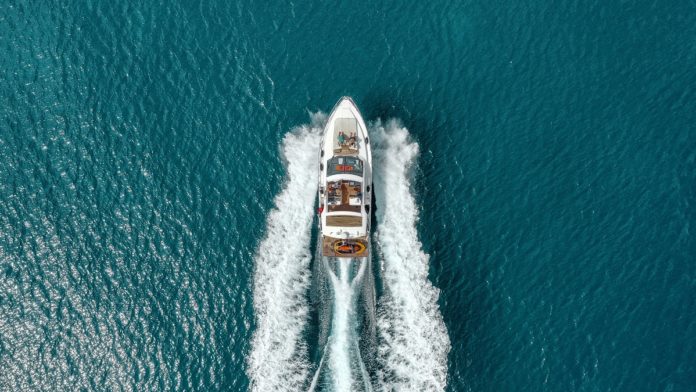
Circumnavigating the globe is not a goal for the faint of heart, and it takes a lot of planning. One of the earliest decisions to make is the boat to choose, and how big it should be. “Navigating the World: Choosing the Right Size Boat for Your Round-the-World Sailing Adventure”
There are a lot of factors that go into the decision, everything from budget to how many people will live on board. And while there’s no right answer to the question for everyone, thirty-five to forty-five feet is the most common size range , for many good reasons which we will explore. And can certainly sail around the world in something larger or smaller.
General Considerations for Boat Size
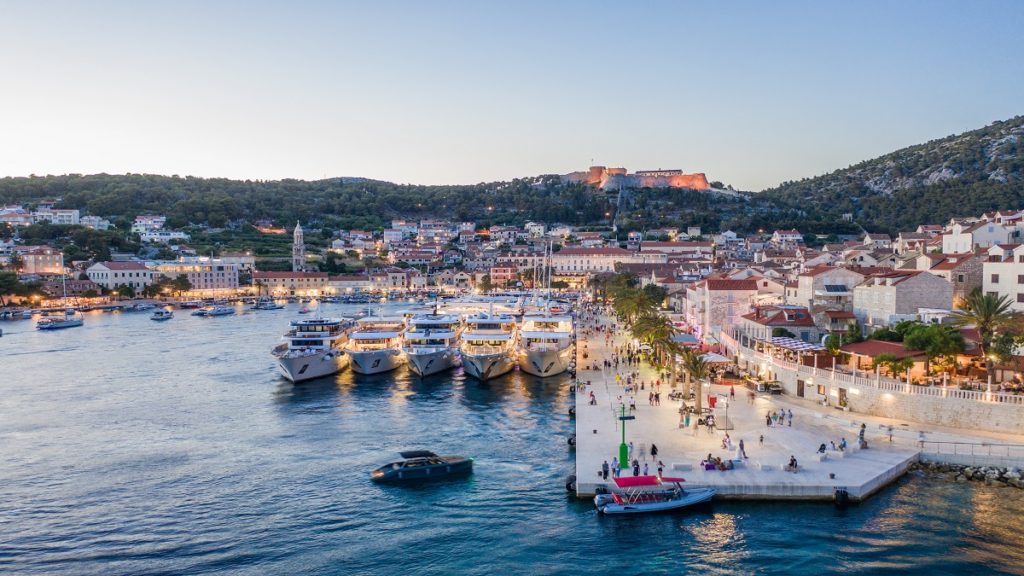
It’s not just how many people you sail with that dictate the space you need, but also how you plan to circumnavigate. If you’re planning to spend five or ten years meandering around the world, then speed isn’t a problem. But if you’re joining an around the world rally with a circumnavigation in twelve to eighteen months, you’d be hard pressed to do it on a slower boat.
And how you get there is important, too. Island hopping across the Pacific is slow and comfortable, and a pretty gentle route. But heading down the coast of South America to do a high latitude crossing in cold weather means you need a lot more boat.
Finally, the slower you go, the more time you’ll spend not sailing. And boat size has a tremendous impact on comfort at anchor. A tiny boat may work fine for slow, solo-sailing meander around the world, but a larger group will need some elbow room for those months of exploration when you’re stopped.
Read also: Top 3 Yachts For A Memorable Mediterranean Yacht Charter Experience
Sailing around the world: Monohull or Catamaran?
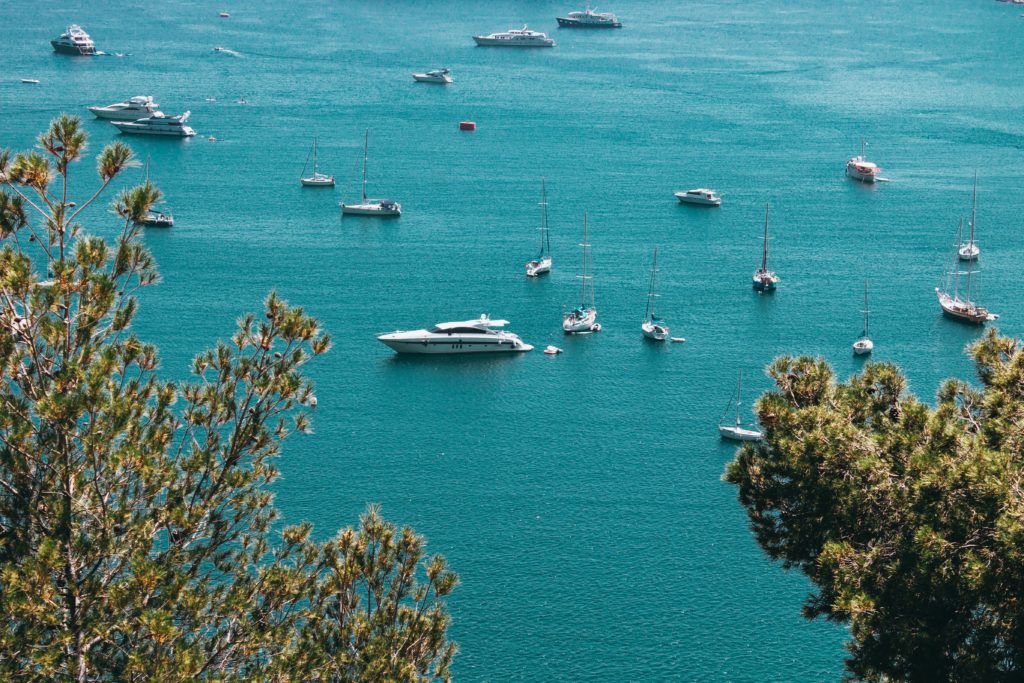
The choice of a monohull versus a catamaran is a topic of its own, and there are many advantages and drawbacks to either type of boat. Issues of safety, comfort, reliability, price, and personal preferences all go into the discussion.
More monohulls have sailed around the world
While catamarans aren’t a new concept, the blue water cruising catamaran is a more recent development. Because monohulls have been circling the globe for over a century, more of them have completed the journey. That doesn’t mean they are inherently superior, but that there is more data available about their suitability to the task.
Catamarans are comfortable (except when they’re not)
At anchor, it’s tough to compete with a catamaran for comfort and stability. The huge bridge deck area and cockpit make for spacious living quarters, and the broad platform doesn’t rock and roll. And while sailing, a catamaran does not heel much, so sailing on more upwind angles is more comfortable without all the tipping.
But in terrible conditions, catamarans can be miserable. Steep, choppy waves are uncomfortable for any boat, but a catamaran may pound those waves with a low bridge deck. Cats with lower bridge decks are more prone to this, but it can happen to any catamaran if the waves are big enough. Constant pounding for hours or days is miserable.
Monohulls are usually cheaper
Building a single hull is much easier than building two hulls and joining them with a bridge deck that won’t flex and twist under all the loads at sea. And material costs are higher for two hulls, as there is so much more volume. And many marinas charge extra for multihulls because of their high beam, sometimes they may charge you for two slips!
Safety Comparisons
If a monohull capsizes, it has a keel to right it, and most monohulls will roll back from it, eventually. Catamarans will not. This is often touted as a major safety difference, and it is a fact to be considered. But consider also that with two hulls and no heavy keel, catamarans are very difficult to sink.
Cruising catamarans are not sailed in a way likely to flip them. The catamarans most likely to capsize are high performance racing catamarans, not cruisers laden with gear and stores and sailed for comfort, not speed.
A full analysis is beyond this article, but both types of boats have safety risks, be it capsizing or losing a keel, with the worst-case scenario of either being quite rare. It’s important to come in with your eyes open to make a realistic determination of the risks you accept.
Read also: Best yachts for transatlantic: our selection and advices for 2023
Monohull sizes to sail around the world
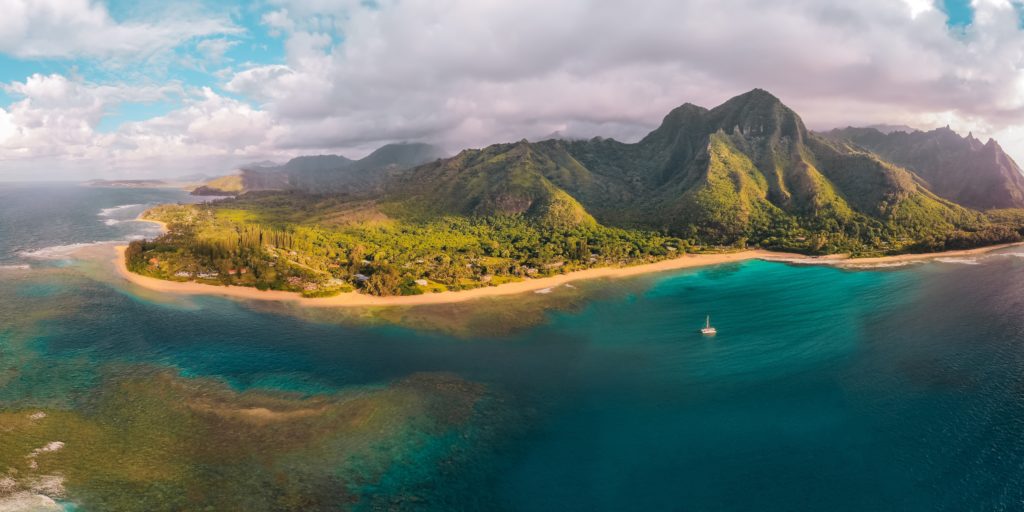
These are rough guidelines only, and you will have to look more closely at individual boats for living space and performance requirements.
Under Twenty-five Feet
While boats under twenty-five feet have sailed around the world, those who did it were on very specialized adventures. The sort of trips that establish your name in the Guinness Book of World Records or the sailing hall of fame. These are cramped trips on very small boats by one person. You can do it, but it’s more of a stunt than a lifestyle.
Twenty-five to thirty-five feet: for cost conscious adventurers
If you are sailing around the world on a boat under thirty feet, more power to you. It’s possible, but it will be slow and possibly cramped. Thirty to thirty-give feet gets to more reasonable ground for a cruising couple, but too small limits room for gear and stores. But it is a very affordable way to get out and sailing. You’re unlikely to have hot water, and refrigeration is limited.
Thirty-five to forty-five feet: the sweet spot
This size range is the sweet spot for many cruisers. Cruising couples, small families, and other groups do well in this size without costs escalating. The longer boats can get some faster passages and give more range and stores. These boats can have water heaters, more refrigeration and instruments, and even freezers.
Over fifty feet: comfortable, capable, and costly
A couple can comfortably sail larger monohulls with the right sail handling equipment, and they are also good for larger families. With more room for comfort systems, a fully equipped boat over fifty feet will lack for little. Costs are higher, but passage times are a lot faster.
Catamaran recommended sizes to sail around the world
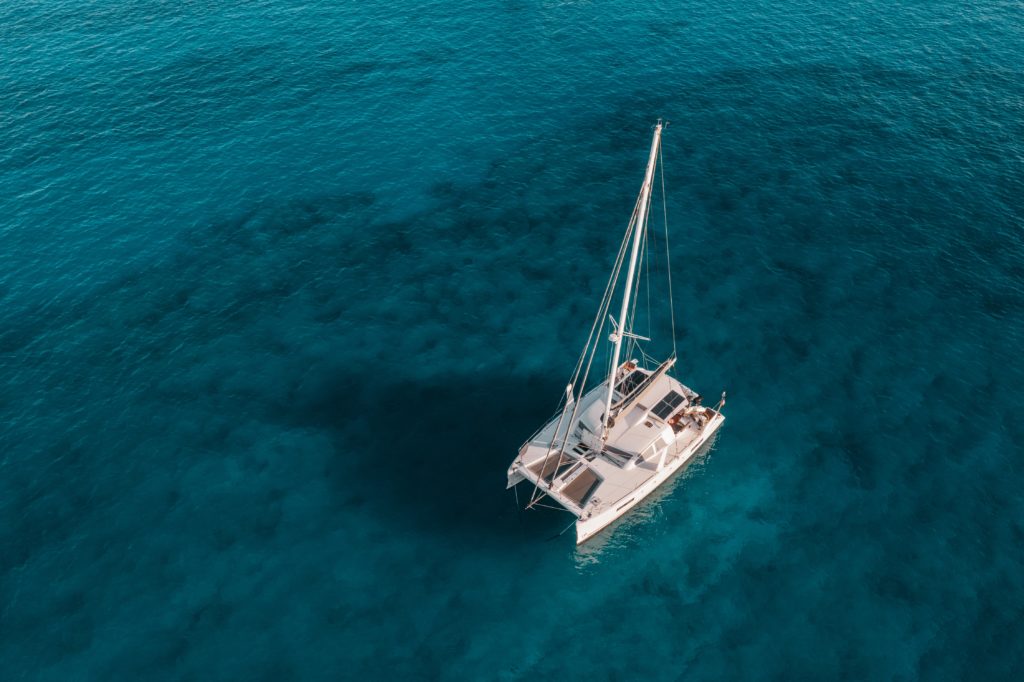
Catamarans have more volume for the equal length in monohulls, but their performance drops off dramatically if overloaded.
Under thirty feet: few and far between
Tiny catamarans rarely have the stores and carrying capacity for crossing oceans, there have been very few built. Most catamarans this small are more suited to coastal cruising.
Thirty to forty feet: Relative comfort and speed
Starting in the low thirty-foot range, there are some solid catamarans capable of blue water sailing, and they offer a good balance between comfort and budget. They aren’t always the fastest, but you’ll have no lack of living space, even if cargo capacity is light.
Forty to fifty feet: the catamaran sweet spot
Manufacturers have focused on the mid-forties in catamaran length, and there are so many options in a broad range of price, style, and configuration. You can find lighter, faster cruising boats or heavier boats with more carrying capacity and interior volume.
Over fifty feet: sail the world in speed and comfort
Larger catamarans are redefining the terms “performance cruising” and “comfort.” When you get towards fifty feet and beyond, the interior volume of these boats is amazing. Some builders have focused on plush comfort, while others focus more on sailing performance. In this range, the boats can get quite expensive, but you’ll have a sailing experience like no other.

The best boats models to sail around the world
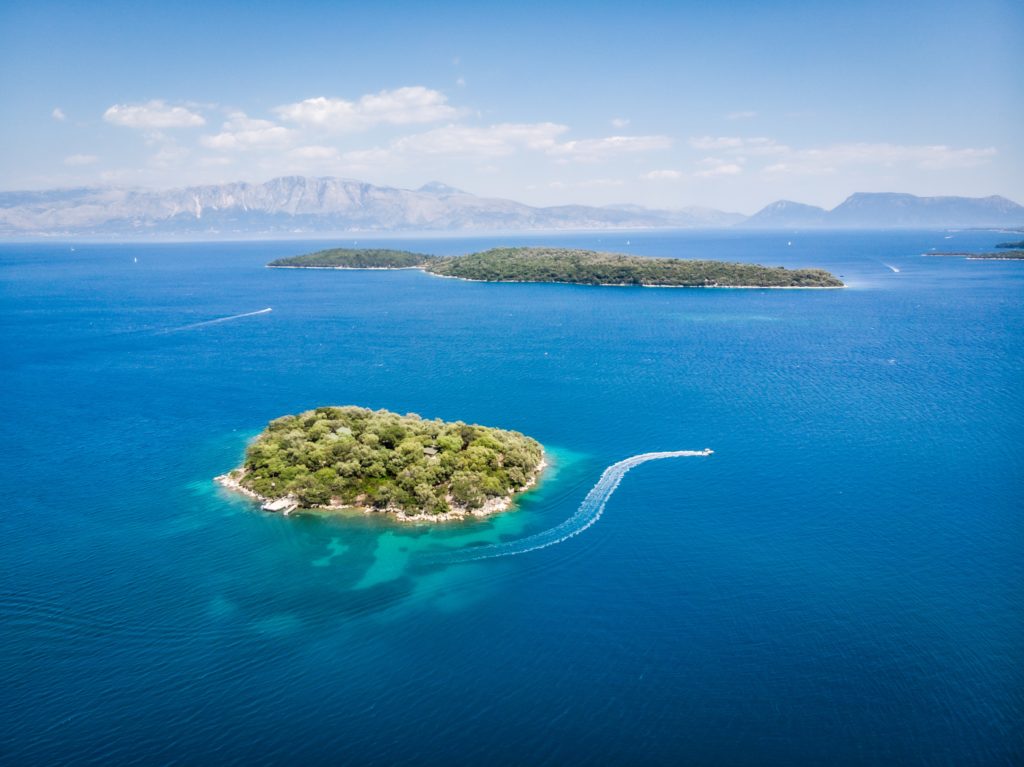
We’ve selected a few solid boats to look at for sailing around the world. It’s not an exhaustive list, it’s a place to look for boats that match your requirements for space, speed, and budget. Every boat listed is one model from a quality brand of boats, so explore the entire range of models for options.
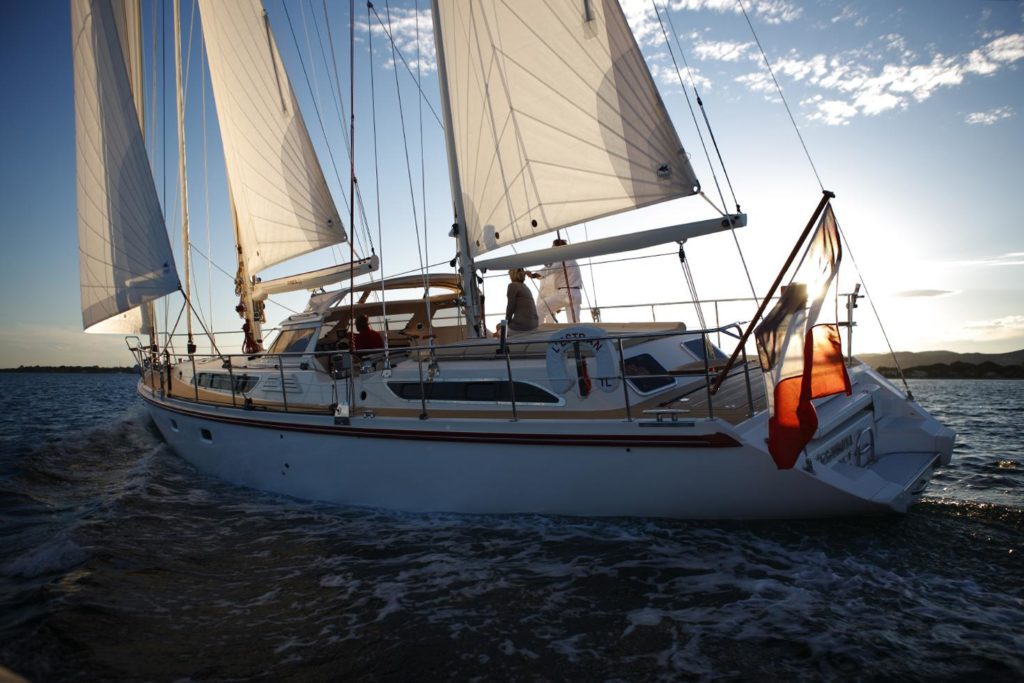
Westsail 32 – a small, sturdy, comfortable boat that will take you where you want to go. Although Westsail went out of business years ago, this model and others are available on the used market, and the Westsail 42 is another popular option.
Valiant 40 – Another classic, older cruiser, the Robert Perry designed Valiant 40 broke a lot of rules about what was supposed to be on a small, ocean-going sailboat. The result was one of the fastest forty-footers for its time, and still an excellent performing, sea-worthy boat.
Hallberg-Rassy 40C – one of the latest offerings from this Swedish builder, it features a modern design built to Hallberg-Rassy’s exacting standards. The entire range of Hallberg Rassy yachts, old and new, are solid, capable blue water sailboats that can handle anything.
Hylas 46 – A good medium displacement cruiser, it has plenty of space for a couple or small family. It sails well, and doesn’t break the bank.
Amel 54 – Cruising ketches from French builder Amel have a fanatic loyal owner base, because of the well thought out and practical designs coupled with solid, high-quality construction.
Read also: Five Easy Beginners-Friendly Sailing Trips And Destinations
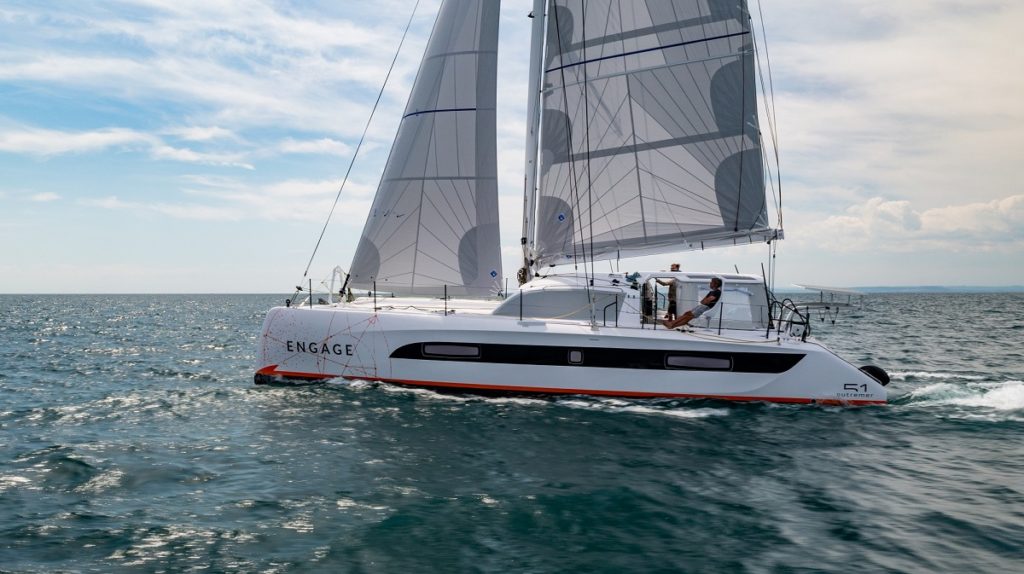
Gemini 105M – At 10.5 meters (34′) this is one of the smallest and most successful ocean-going production catamarans. The Gemini Legacy 35 is an updated version which is also still an excellent option in the small cat market.
Atlantic 42 – The Chris White designed Atlantic catamarans are known for their speed under sail and interior comfort. This is the smallest of the Atlantic catamarans, but it will not disappoint you if you’re looking for a little more performance.
Leopard 44 – Built in South Africa by Robertson & Caine, Leopards are great for on the water comfort and easy handling. The 44 is available in an “owner’s” version, but is also a very popular boat in the charter fleets. Plenty of space for a family.
Fountaine Pajot Bahia 46 – The French-built Fontaine Bahia is an earlier example of one of their many good sailing, comfortable cruising catamarans.
Outremer 51 – while we know Outremer best for screaming performance, their boats are also comfortable, well built, and spacious. If you’re going large and speed is your thing, you won’t go wrong with any of their boats.
The right size for YOU
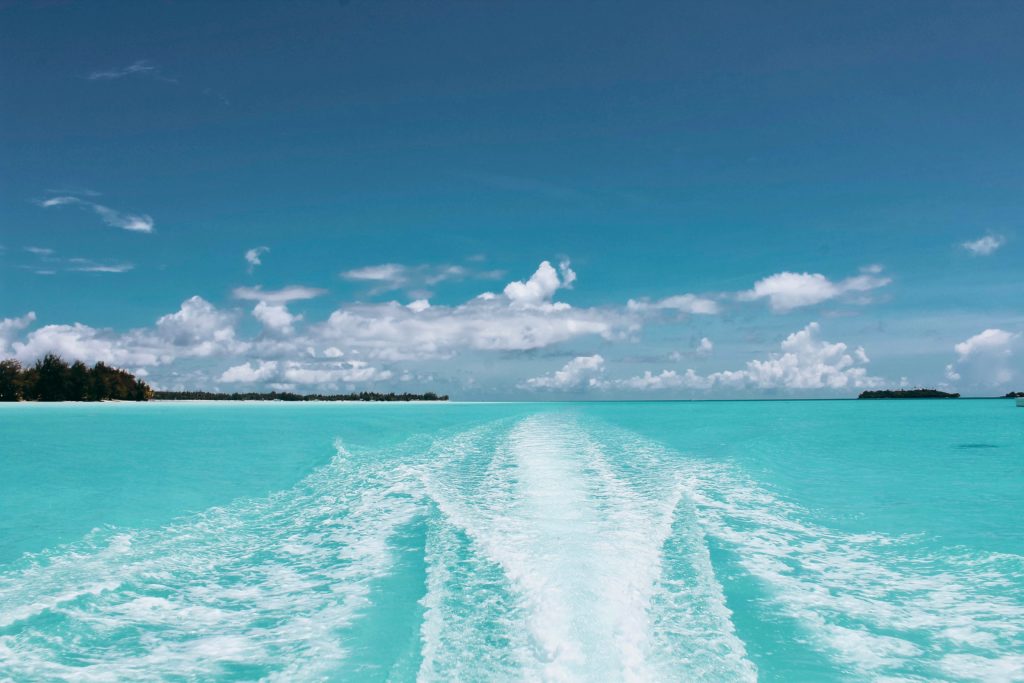
Yes, there are “sweet spots” and “ideal ranges” for boats we can talk about, but no one can dictate the best boat for you and your plans. Remember, when you are looking at boats and considering size, that it needs to work for your plan, your budget, and your skill level. Buying too much boat can be as much of a mistake as going too small for your needs. If you can’t handle the boat or the finances cause you stress, it won’t be fun.
So remember when you look and read all these recommendations, they’re just to give you a baseline in your search for the perfect sized boat for you .
Read also: 10 Best Destinations For Luxury Yacht Vacations
RELATED ARTICLES MORE FROM AUTHOR
5 destinations to sail to for valentine’s day, sailing distance calculator, our favorite power catamarans to charter in the bvi.
- Testimonials
- Privacy Policy

Home » Blog » Travel » So you want to sail around the world. Now what?
So you want to sail around the world. Now what?
By Author Fiona McGlynn
Posted on Last updated: November 20, 2023
Sailing around the world is a major undertaking, but you don’t have to be super rich, athletic, or have salt water running in your veins to do it.
I know bluewater cruisers and round-the-world sailors from all walks of life: young couples, single women , families with kids , and an 85-year-old Reverand .
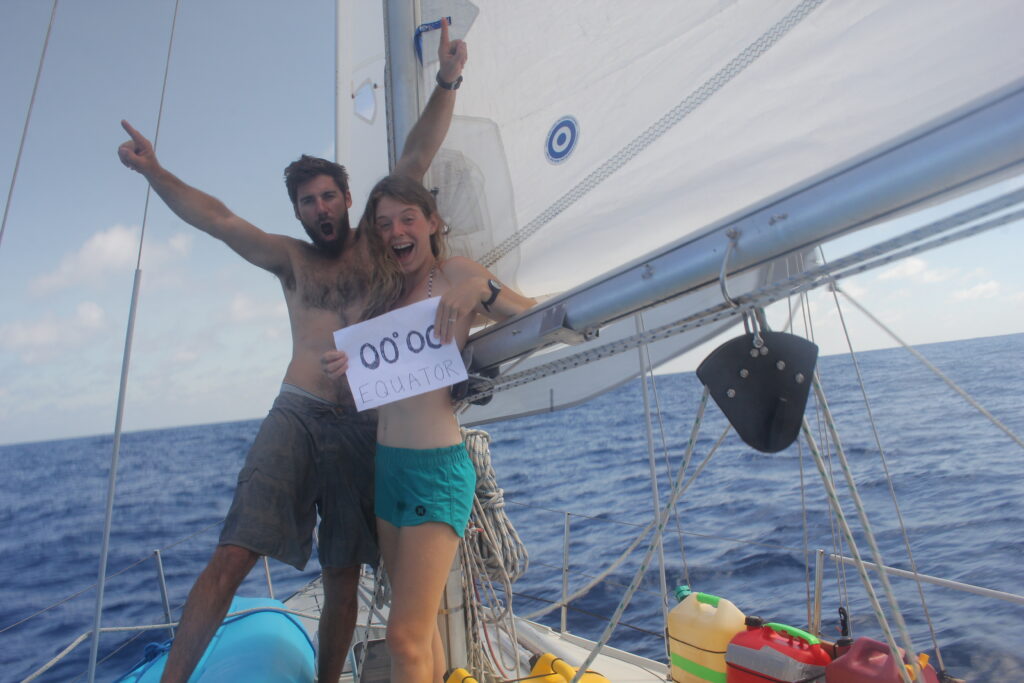
Waterborne is reader-supported. When you buy through links on our site, we may earn an affiliate commission.
When I was in my late twenties, my husband, Robin, and I spent three years sailing 13,000 nautical miles from Vancouver, Canada to Mexico and then across the Pacific to Australia in our 35-foot sailboat.
We didn’t complete a full circumnavigation of the world—our goal was to reach Australia—but that’s pretty common for cruisers our age (I’ll talk more about routes and timelines below).
I grew up dinghy sailing and Robin had no sailing experience at all. We had office jobs, average incomes, and knew almost nothing about bluewater sailing when we started.
It was two years from buying our boat to casting off the dock lines and setting sail. However, we did 95% of our preparation in the year before we left. This just goes to show how quickly you can go from “dreamer” to “doer”.
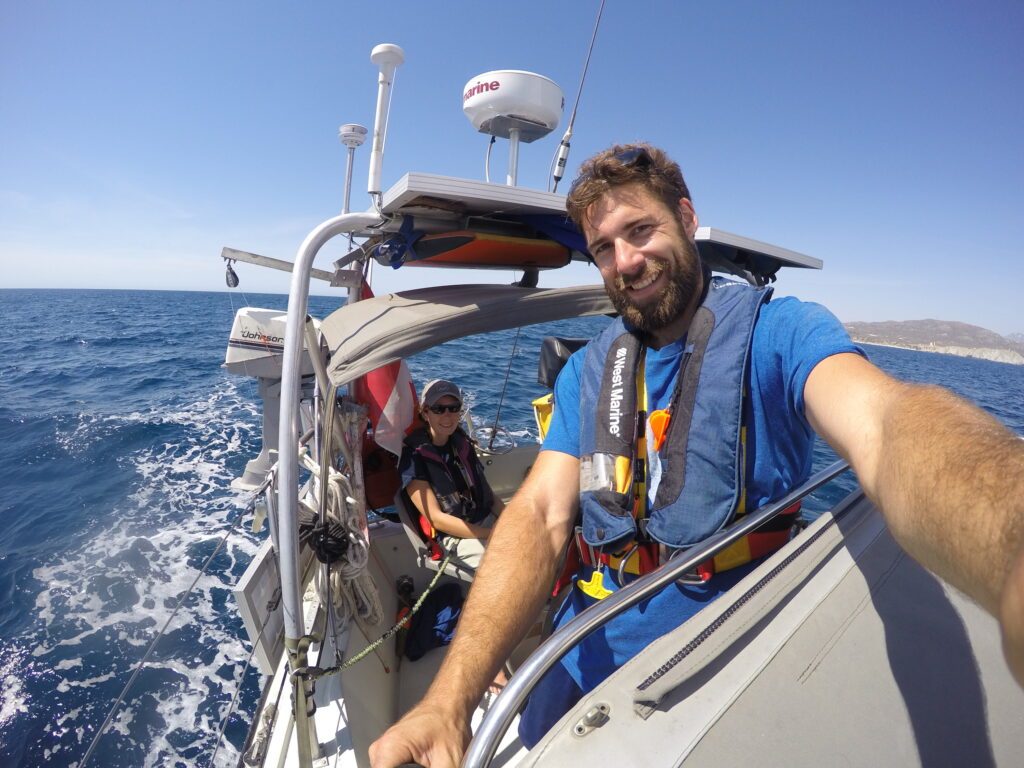
How to sail around the world
For every bluewater cruiser I know, I can think of dozens of “armchair sailors” who dream of sailing around the world but never get out and do it.
Why? There are some big hurdles to overcome before you set sail: getting offshore experience, finding the right boat, outfitting it with all the right gear, learning how to be self-sufficient, and fixing things that break.
Not to mention finding a way to finance it all.
There’s also a strong psychological and social element: “What will my parents, friends, and colleagues think?” “Will I be able to find work again with a big hole in my resume?”
Going bluewater cruising is a radical departure from the norm and an entirely new way of living. You’ll be faced with challenges, but that’s what makes it such an incredible experience.
If you want easy travel, get a camper van. Sailing around the world is a life-changing adventure.
So, I wanted to share how we made our transition from landlubbers to bluewater cruisers and share a few resources to help you on your way.
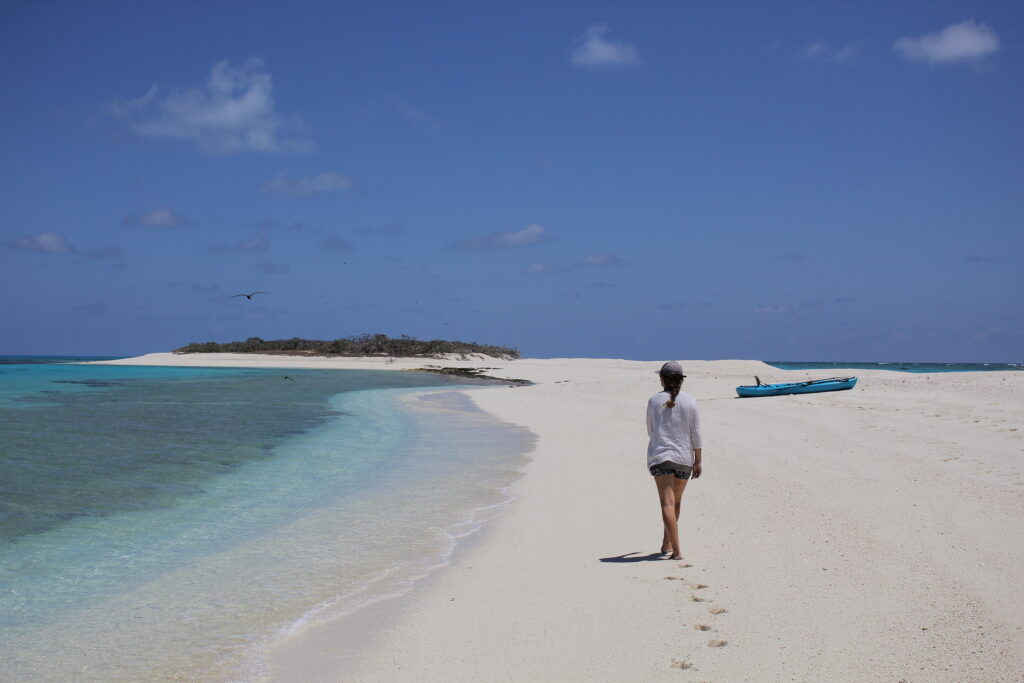
1. Get some offshore sailing experience
Sure sailing around the world sounds romantic—the freedom of the open ocean, sunsets on a beach in Bora Bora, sipping fresh water from a coconut you picked yourself (words of caution: climbing a palm is much harder than it looks!).
But are you willing to put up with the not-so-fun stuff that comes with it? Seasickness , scary conditions, sleep deprivation from sailing at night , repairing your boat when it breaks (which it will), and being thousands of miles from friends and family?
Some of the best moments in my life were on the boat, but I’ve also had experiences that put me way out of my comfort zone.
It’s not simply a matter of being mentally tough (though that helps), some people are just never going to enjoy the sailing life.
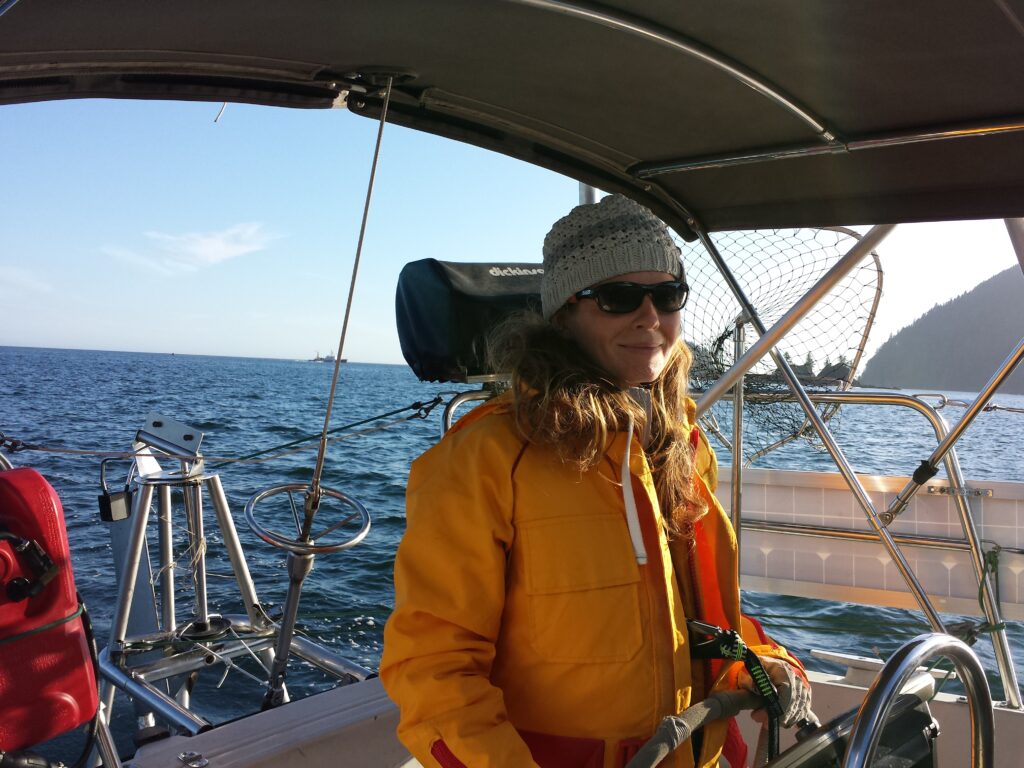
The question is: is it right for you? What about your partner, your kids, or whoever else is coming along for the ride?
Bluewater sailing can blow up relationships. I’ve heard many stories about sailing couples investing tens of thousands in their boats, only to set sail and discover that one or both of them hate it.
So, before you buy a bluewater boat, quit your job, or give up your studio apartment, you (and your crew mates) should go and get some offshore sailing experience .
Spending a week on an offshore passage will not only teach you valuable skills, but it will also give you a taste of the challenges and joys that come with bluewater cruising.
There are plenty of ways to get experience if you don’t already own a boat:
- Take a course at an offshore sailing school
- Try sailboat hitchhiking
- Look for crewing opportunities (or pay for a spot) on a rally boat in the ARC (Atlantic Ocean crossing), Pacific Puddle Jump (Pacific Ocean crossing), or Baja Haha (San Diego to Cabo).
- Become a crew member on a friend’s boat
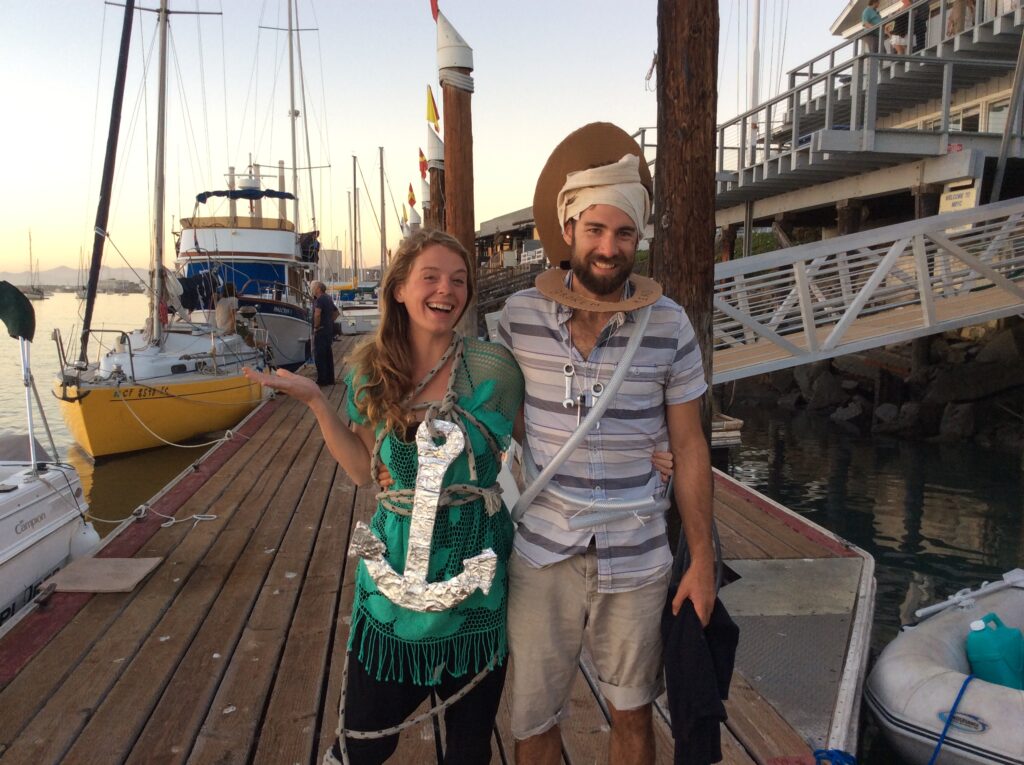
2. Find your community and immerse yourself in cruising culture
If you want to go cruising, you’re going to need a support network of people who’ve been there and done it.
We received so much help leading up to our trip (and along the way). Our liveaboard friends and neighbors in Vancouver helped us fix up our engine, rewire our boat, and find a great deal on a new set of sails, just to name a few.
There are lots of ways to find your sailing community , either online or in person. I highly recommend mooring your boat in a liveaboard marina , where you’ll likely be surrounded by other bluewater cruisers.
You can also learn a lot from other people’s stories. Immerse yourself in bluewater cruising culture: read the classic sailing books , subscribe to a magazine like Good Old Boat or Cruising World , listen to sailing podcasts , and follow a few sailing Youtube channels or sailors on Instagram .
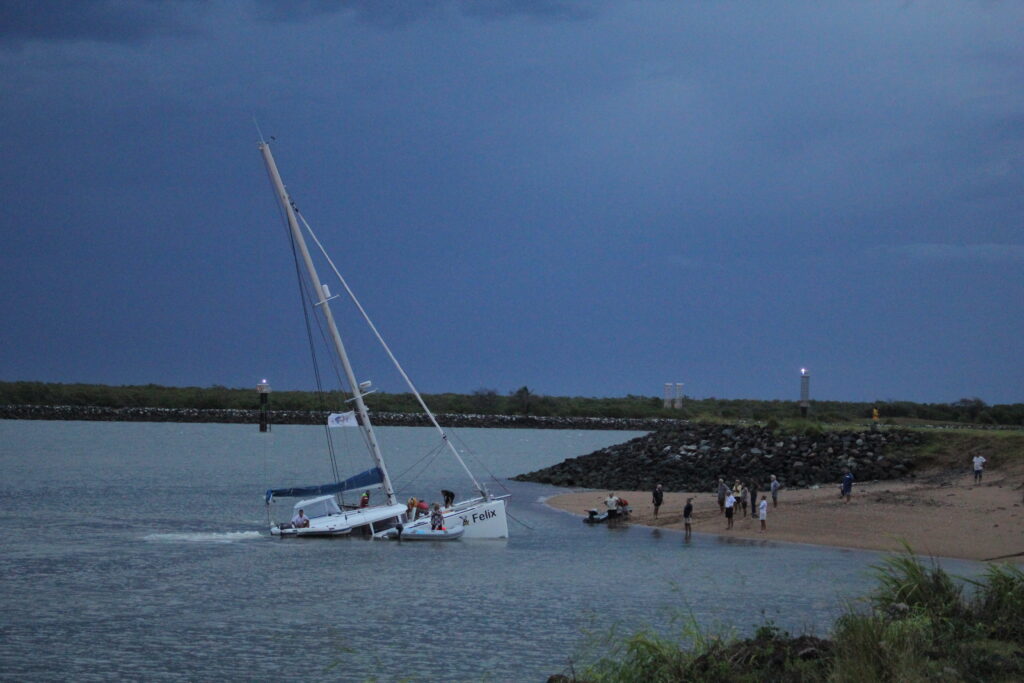
3. Make a plan
There are many different routes for sailing around the world. Most cruisers sail the easier legs—following the trade winds across the Atlantic and Pacific, transitting the Panama Canal —and spend their time exploring beautiful places and cruising grounds like the Galapagos Islands, French Polynesia, and New Zealand.
Only a few cruisers take on the harder routes—transiting the Northwest passage, Southern Ocean, or Indian Ocean (perhaps you’ve heard of the infamous Cape Horn or the Cape of Good Hope?).
For route planning, I highly recommend picking up a copy of Jimmy Cornell’s World Voyage Planner which shows you how to sail from anywhere in the world to…well, anywhere in the world.
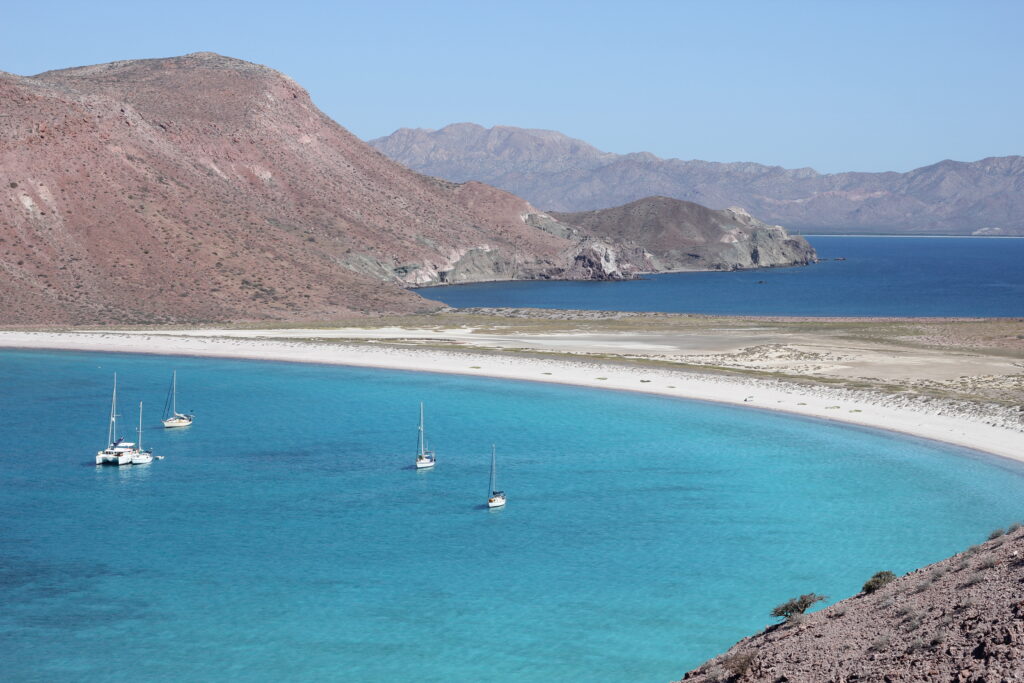
How long does it take to sail around the world?
The current world record for sailing around the world is 40 days, 23 hours, and 30 minutes (IDEC 3, skippered by Francis Joyon). But unless you’re going for the speed record, you’re going to want to visit the different countries you sail to.
I know cruisers who’ve circumnavigated in as little as five years and others who spend decades making the big loop.
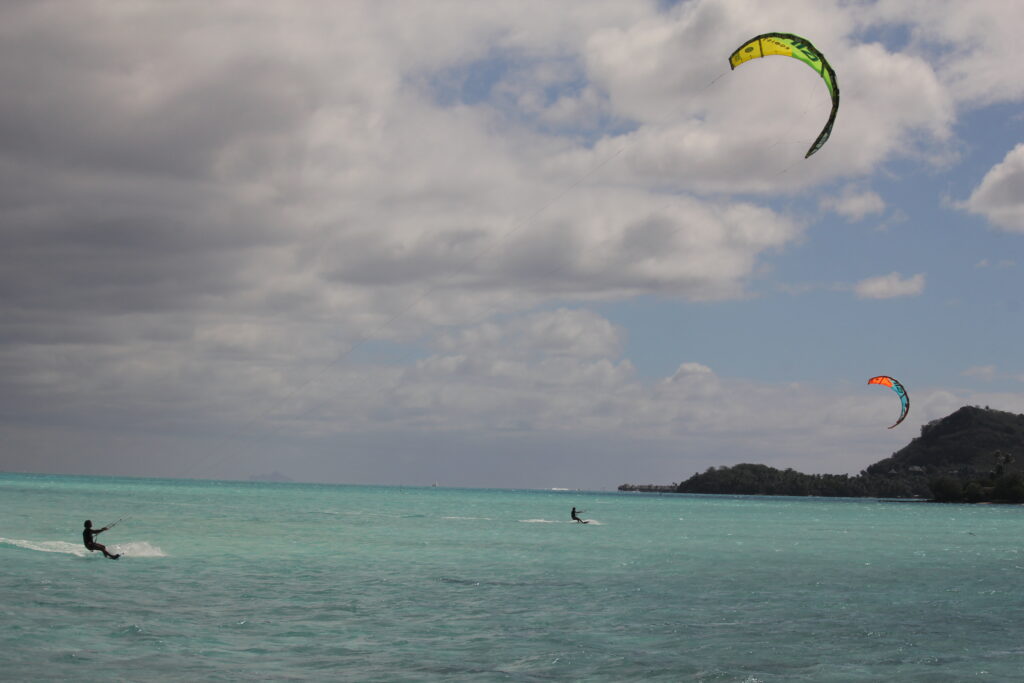
In my experience, it doesn’t pay to be in a rush because inevitably things don’t go to plan.
Your boat will break down and need repair which often means spending time in a boatyard.
You may find yourself waiting weeks if not months for crucial parts.
You may need to fly home in the middle of your cruise (as we did) when a relative is ill or dies.
Or, you may just fall in love with one of the remote places you visit and want to stay for a while.
Bad weather and hurricane season will dictate when and where you sail. For example, we had originally planned to cross the Pacific in 2016, but we didn’t feel ready. So, we waited a whole year for the right conditions and crossed in the spring of 2017.
My recommendation is to give yourself a minimum of three years to trial the cruising life . Make a plan but don’t be disappointed if you have to throw it to the winds.

4. Make a cruising budget
When people learned that we were traveling the world on our sailboat, they often assumed that we were independently wealthy, which couldn’t have been further from the truth!
We’ve cruised for as little as $1000 a month, but when it comes to cruising budgets, the sky is the limit. It all depends on:
- Your boat . Smaller boats cost less to buy and maintain.
- Destinations . We found places like Mexico and Fiji very affordable, while places like French Polynesia and Australia were quite expensive.
- Your timeline. Most of the young cruisers we knew were on three-year timelines (because that’s what they could afford). The retirees and families we met often had the financial means to cruise for longer (sometimes indefinitely). Some had houses that they rented, and others would take breaks in places like New Zealand where they worked regular jobs.
- Whether you’re willing to work along the way. We wrote for sailing magazines while we were cruising, but it wasn’t enough money to fund our trip. We mostly relied on savings. With technology like Starlink and the post-pandemic remote work boom, it’s probably easier today to earn money while cruising . However, cruising is a full-time job. It can be challenging to cover ground while keeping up with work commitments
- Your lifestyle. As I mentioned, it’s possible to sail around the world on a budget . But we lived pretty rough: no air-conditioning, no freezer, no hot water—at one point, we hadn’t taken a shower for 8 months!
When making your budget, I’d suggest perusing a few sailing blogs where cruisers post their monthly expense.
Also, there are plenty of creative ways to finance a sailboat . Some people even manage to travel the world for free by buying and selling their boats in the right markets .
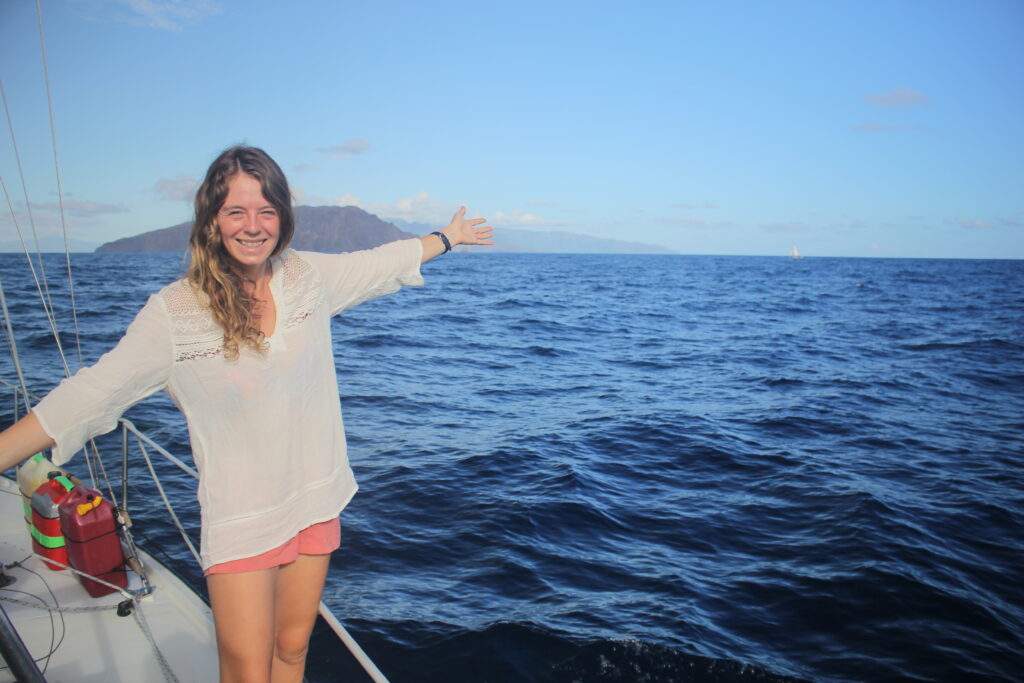
5. Buy a bluewater boat
You can’t sail around the world in any old sailboat. Bluewater boats have specific design characteristics that make them appropriate for offshore sailing.
I love data, so I made a list of the best bluewater sailboats by looking at 2,000 boats that were entered in the Pacific Puddle Jump, a cross-Pacific rally, over the last decade. We also have a list of smaller boats which I recommend if you’re on a budget.
Once you have your list, you can get busy searching YachtWorld, Craigslist, and these other great places to buy used boats .
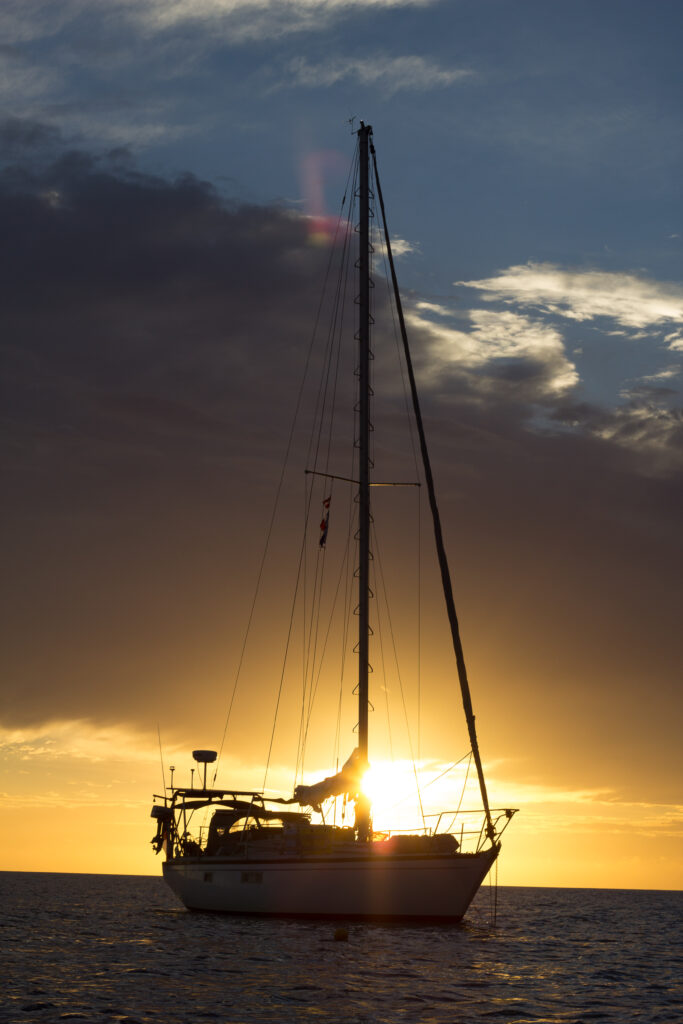
Keep in mind that a bluewater boat isn’t necessarily a seaworthy boat. It may have structural damage, unsound rigging, or need an expensive retrofit. Uncover any lurking issues (and know what they’ll cost to fix) before you sign on the dotted line.
We had a very in-depth boat checklist that we used to inspect every boat we considered buying. We also hired an accredited marine surveyor, twice, to survey every detail of our boat. The first time was for the purchase, the second time was when we were preparing to go offshore.
For more on how to search, understand boat values , and close the deal, check out our series on how to buy a boat .
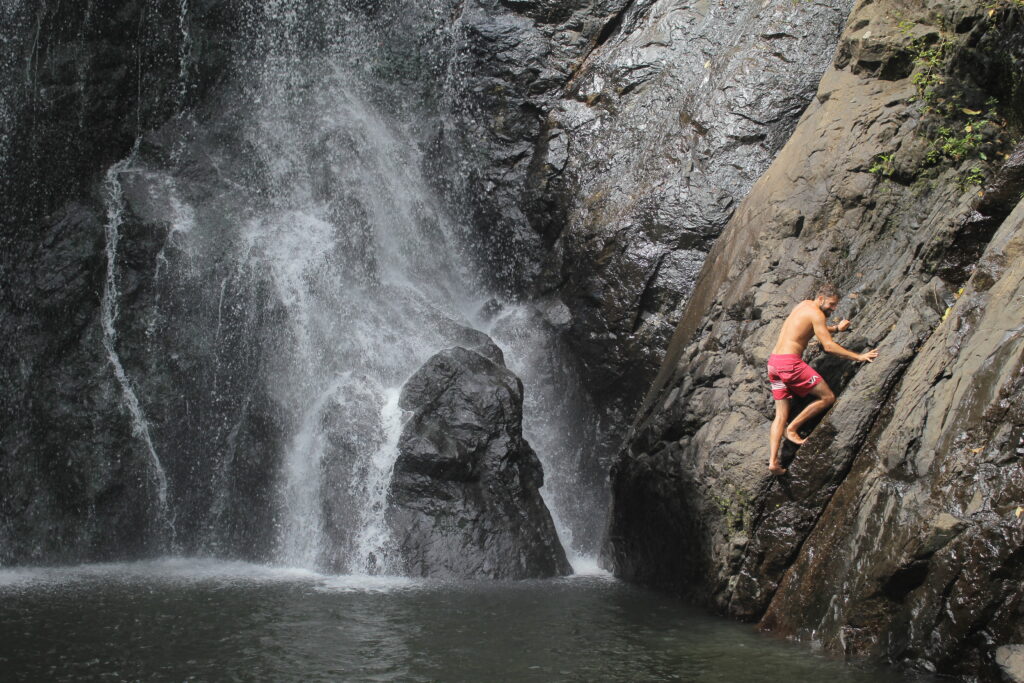
6. Live on your boat
The next big step on your cruising journey will be moving onto your boat.
We lived on our boat for two years before we set sail and it taught us so much about the boat (read: what needed to be fixed) as well as ourselves (and whether we could handle close-quarter life).
By moving aboard you’ll learn if living on a boat is right for you and your family. You can also save a bunch of money for your trip. After two years of living aboard, our rent savings paid for the purchase of our boat.
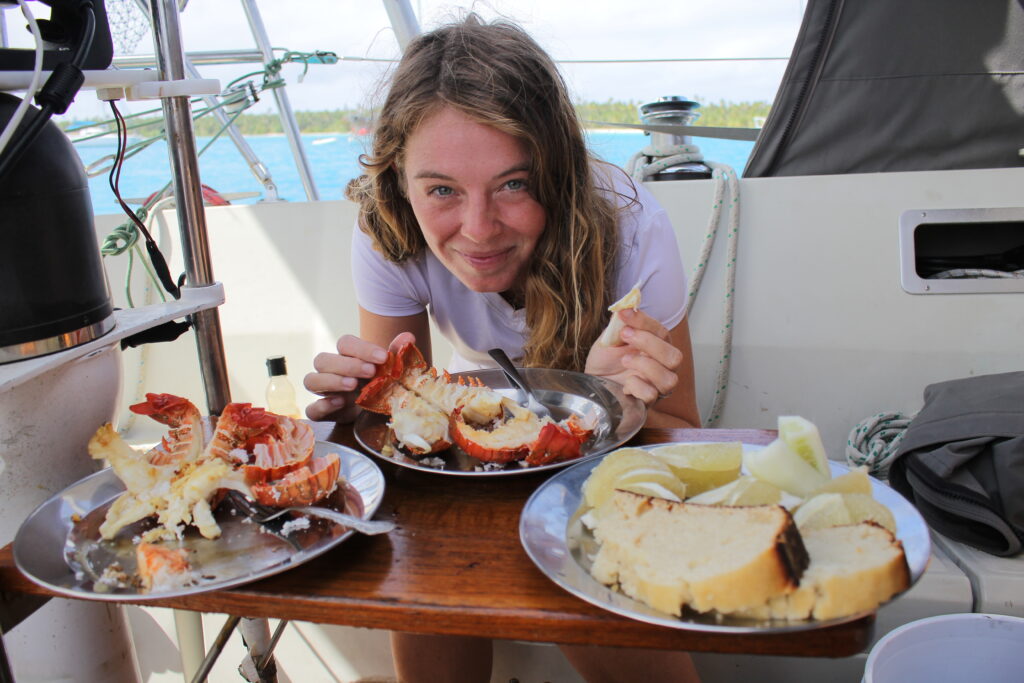
7. Prepare yourself
Preparing yourself for going offshore is a major undertaking. You’ll need to learn advanced navigation, weather, and excellent seamanship, among other things.
It’s not enough to know the theory. Get out and practice with your gear and become comfortable with maneuvers like reefing, heaving to , sailing downwind with a pole out genoa , and anchoring under sail .
In addition, you should become intimately familiar with your boat’s systems. Sailboats break down at sea (here are the most common problems ). So, you have to be capable of fixing your boat when you’re hundreds of miles from shore.
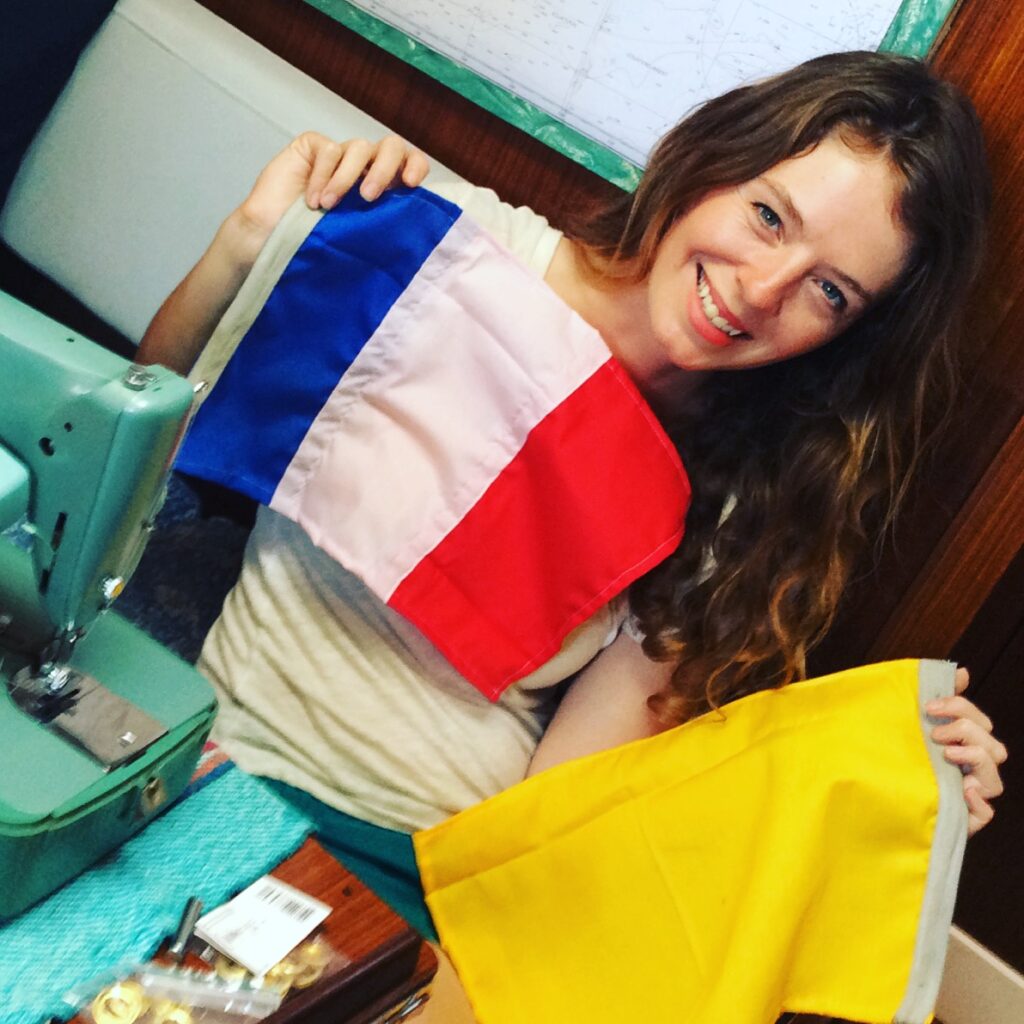
Become an expert in your boat’s electrical system , propulsion, rigging, sails, and plumbing, before you go.
When the pandemic hit, a lot of sailing education moved online. Now there are plenty of great online sailing courses covering everything from learning the parts of a sailboat to celestial navigation.
That being said you can’t beat on-the-water instruction and offshore experience (see #1 for offshore sailing courses).
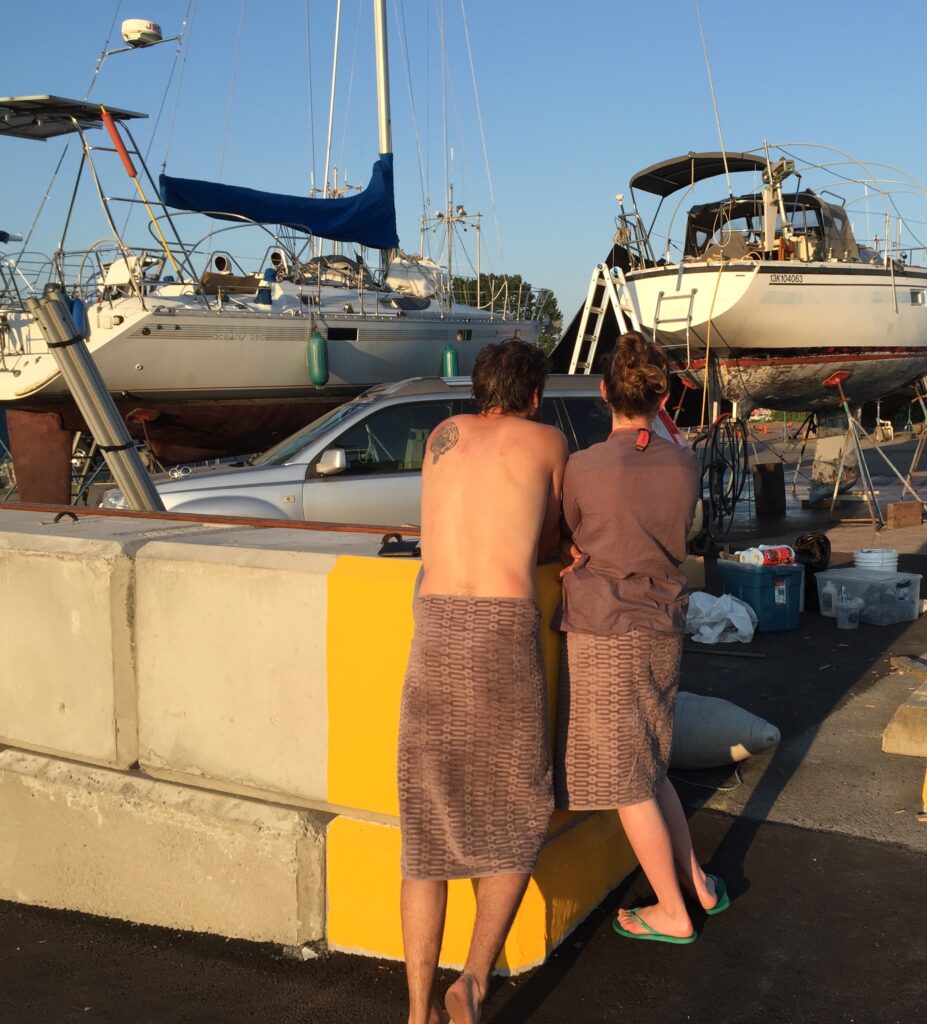
8. Outfit your boat
Preparing your boat for offshore will take dedicated effort and money, especially if it’s an older boat that’s not been previously equipped for bluewater sailing.
In addition to fixing existing issues and replacing old equipment, you’ll want to add offshore gear like a watermaker , a boom brake , downwind sails , self-steering wind vane, life raft, satellite phone , AIS, solar panels, and inverter.
Not to mention all the spare parts you’ll need to keep these systems running.
Needless to say, outfitting can get pretty expensive but you can save money by buying used boat parts and second-hand sails .
We spent six months in the boatyard, working full-time on our 1979 Dufour 35 to get her ready to sail. We built a solar arch , installed panels, replaced our rigging, added a roller furler, replaced our anchoring setup, removed 30 years of antifouling paint, and much much more.
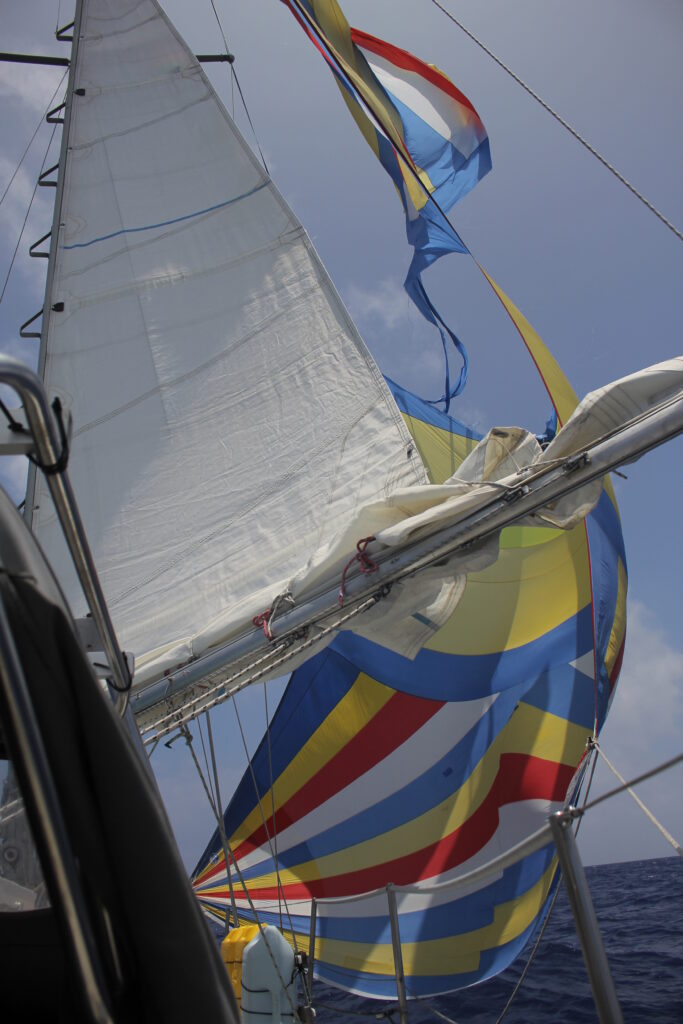
9. Do a shakedown cruise
Next, it’s time to test your boat (and yourself) by taking it on a shakedown cruise. The idea of a shakedown is to test your boat’s performance after any major changes or repairs. The goal is to find any issues (and fix them) before going farther afield.
We circumnavigated Vancouver Island for our shakedown cruise. It took us a little over a month and allowed us to test our systems in a variety of conditions including ocean swell, fast currents, and light and moderate wind speeds.
Despite checking and fixing every system on our boat over the preceding months, we still had issues. Our engine quit, we struggled to get our wind vane working, and we had to make a few adaptations to our brand-new sails. But that’s the whole point of a shakedown cruise!
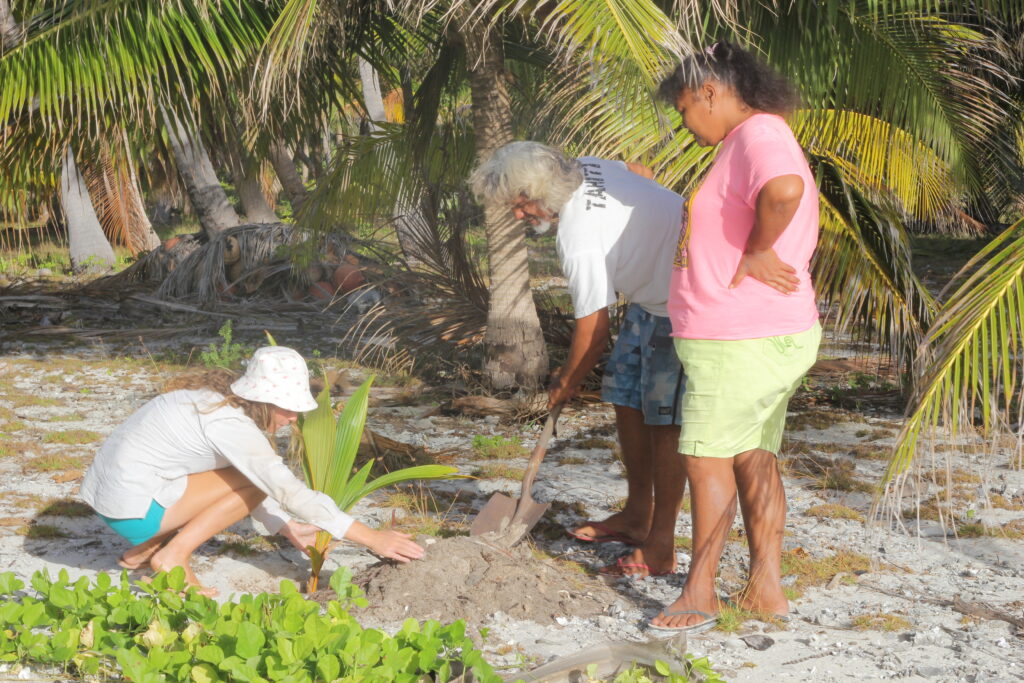
10. Go now!
“Go small, go simple, go now” is a popular cruising philosophy and one that we adhere to.
Life is short and we’ve seen poor health and other life situations bring cruising adventures to a halt.
There’s no ideal time to go cruising. You can be young or old, with or without kids, retired or working.
Certainly don’t wait until you can afford a larger boat. A small boat was our ticket to cruising early in life because it made it more affordable.
If your dream is to sail around the world, start working towards your cruising dream NOW. You won’t regret it.
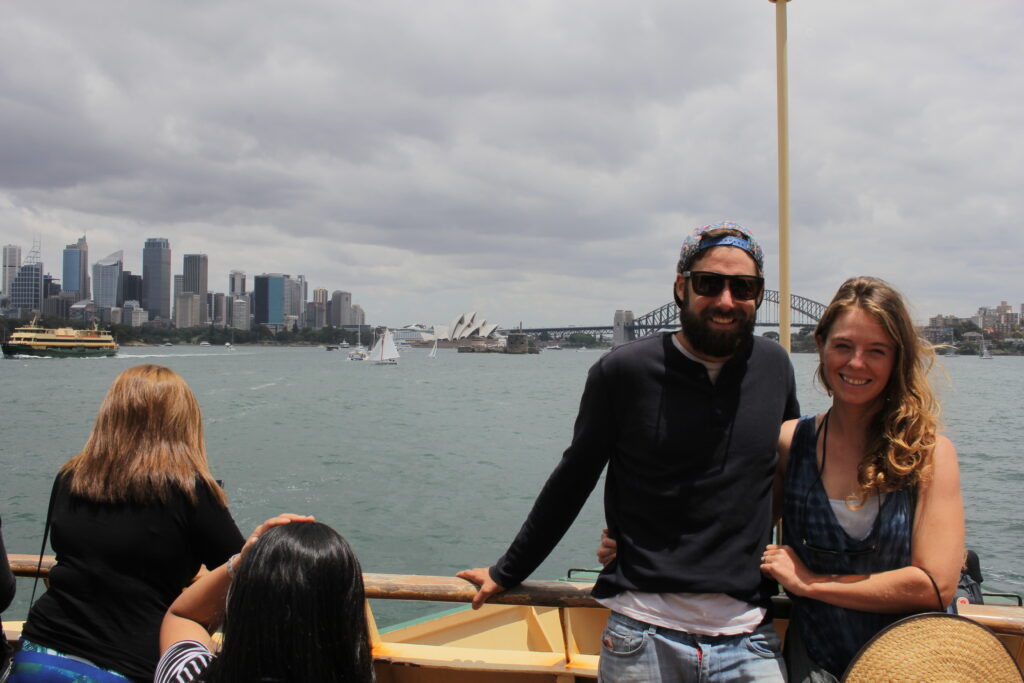
Let us know how we can help you on your bluewater journey and what topics you’d like to learn more about by leaving us a message in the comments.
Fiona McGlynn is an award-winning boating writer who created Waterborne as a place to learn about living aboard and traveling the world by sailboat. She has written for boating magazines including BoatUS, SAIL, Cruising World, and Good Old Boat. She’s also a contributing editor at Good Old Boat and BoatUS Magazine. In 2017, Fiona and her husband completed a 3-year, 13,000-mile voyage from Vancouver to Mexico to Australia on their 35-foot sailboat.
Terms and Conditions - Privacy Policy
How Big Should a Sailboat Be to Sail Around the World?
I see you've already started googling your research and want to know how big of a boat you need to circle the globe. Well, search no more, this article is here to tell you in-depth what size boat you need to sail around the world.
How big should a sailboat be to sail around the world? The best sailboat size to sail around the world is 35 to 45 feet. Smaller boats of 25 feet will be more uncomfortable and inconvenient; it is, however, possible. Larger sailboats of 60 foot and up will be more comfortable, but they are more expensive as well.
Read on, we will have a look at these statements more closely; a cookie-cutter approach is never good, so we will analyze it a bit more in-depth. Obviously, it depends on your specific situation.
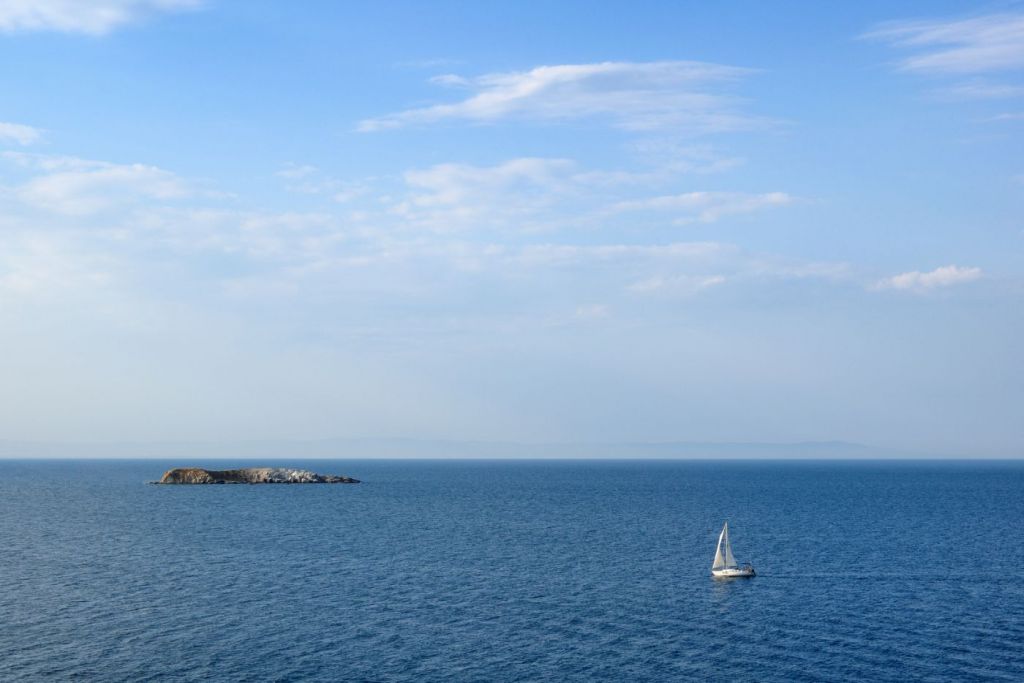
On this page:
What's the ideal boat size to sail around the world, does (boat) size matter, small boat circumnavigations, the ideal boat size for circumnavigations, large boat circumnavigations, in conclusion….
The ideal sailboat size to sail around the world is between 35 and 45 feet long. This length will ensure a high enough maximum hull speed, good handling in high waves, and enough cargo capacity to carry multiple weeks of food and water. Longer boats will perform as well, but are more expensive too.
The most important factors in sailing around the world are:
- cargo capacity & supplies
Longer boats are faster and can carry more cargo, which you will need for circumnavigation. Especially water can take up a lot of space and weight.
Smaller boats will have less cargo capacity. Smaller boats are slower as well, which increases the need for cargo capacity since you'll need more water and food.
Boats over 45 feet long will get disproportionally expensive. However, there are a lot of boats available between 35-45 feet for very reasonable prices.
We did research on average sailboat prices by comparing thousands of prices for you. Learn more on the average cost of buying & owning a sailboat here.
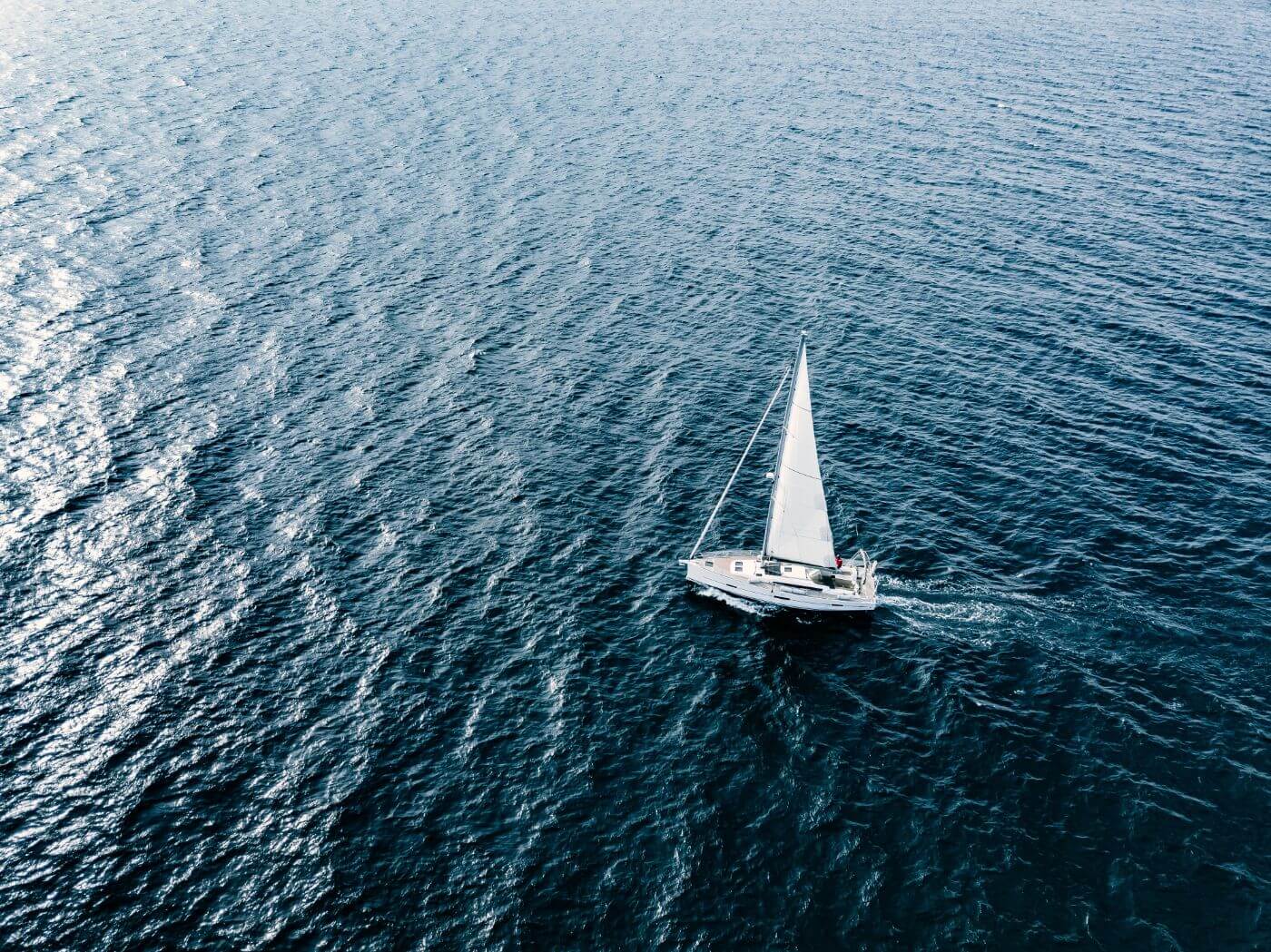
The first thing you're probably thinking about is whether your boat of choice can handle the weather, the waves, and the long journey. But contrary to what you might have been led to believe, size is less relevant than you probably think.
Not that it doesn't matter in the overall picture, it does, but for very different reasons.
You see, a 20-foot Flicka is just as capable of crossing oceans as is any seaworthy 60 footer. It is more tricky to handle, especially in harsh conditions, but the boat's size doesn't necessarily impact its bluewater abilities .
As long as you stay within a reasonable range and keep away from 10-foot dinghies, of course. Though the smallest boat to ever cross the Atlantic had just a bit over five feet.
Respect to Hugo Vihlen, the man who operated this miracle.
Now I understand you aren't asking how big a boat can be to circumnavigate, you are asking how big it should be. But the reason I started with explaining that even small boats can do the job is that sailing around the world can get pretty pricey.
I wanted to make sure you know that even if your budget isn't the largest, so you can't go for a bigger boat, that shouldn't necessarily stop you from getting what you want.
With that in mind, let's kick this off with what it means to sail around the world on a small boat and work our way up in size.
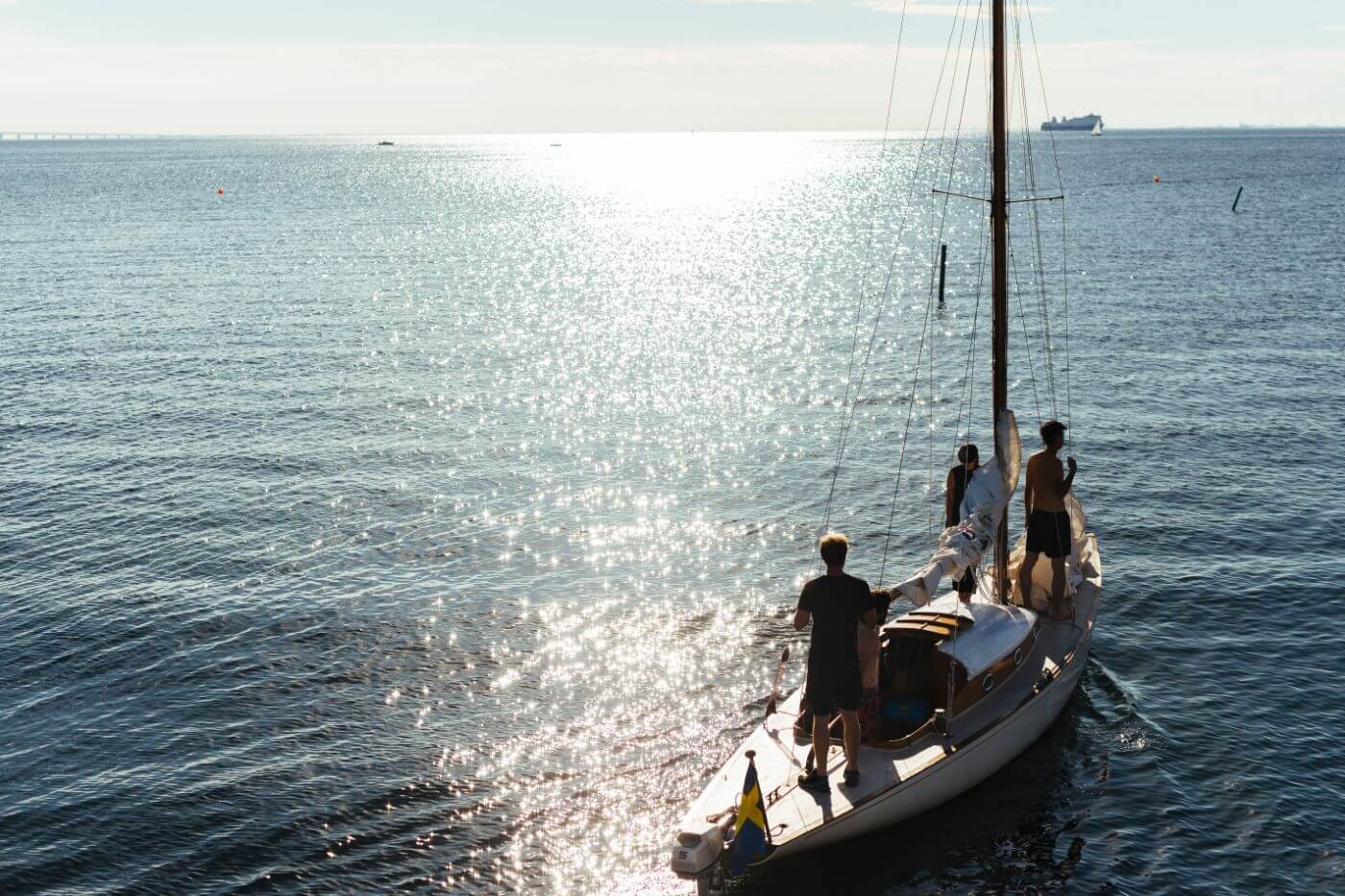
Now that we've established that small boats can too be seaworthy, let's see the drawbacks.
Such a vessel will take you from point a to point b successfully, but you might face issues when it comes to its speed.
There is a thing called hull speed, something too complicated for my simple mind to understand beyond this simple statement:
'because of physics, the longer the boat, the faster it can go'.
So a 1000 mile crossing with a 20 footer will be significantly slower than with a 50 footer, even with the same weather conditions. If you are in a hurry, take this into account.
Longer journey means more supplies
Also, take it into account when planning the logistics. If your passage takes more time, you will need more supplies, for which you need more space - and on a small boat, that spells possible storage space issues.
Dried meat and oatmeal isn't particularly bulky, but water volume is non-negotiable. And you need at least a couple of liters per day .
Even if comfort is not an issue for you and you don't mind spending a few months in a tiny warehouse full of provisions with not much room for yourself, supplies, paired with all the necessary equipment you need, become heavy and a small sailboat can find itself being quite overwhelmed by the weight, becoming more difficult to maneuver.
Which is the last thing you want when facing the Poseidon himself in the middle of the Pacific Ocean.
Just calculate the weight of water you will need for a four-week crossing - something you may easily encounter when sailing around the world.
Even if you minimize the freshwater use and have it for drinking only (hello salty showers) you will easily get to nearly a hundred kilos, and that's just for one person.
On an average 5,500 lbs 20 footer, you might end up in a passage situation where just water for two people makes up 10 percent of the boat's weight, which isn't ideal.
Small boats are more affected by waves
Last but not least, small boats will be influenced by the waves more than larger ones would be. Again, they can deal with them, but the question is if you can. The constant up and down movement can wear even an enthusiastic explorer down.
I understand that this is a matter of comfort, something which many of you hardy ones won't need. Just putting it out there to warn you ahead of time.
What you ideally want is to have your boat be around 40 feet, give or take five. This size will give you enough space to store all you need for long crossings, you can fit a partner plus a bunch of friends on it and its sails and keel are likely big enough to have your back even in rougher conditions.
Moreover, at this size, boats still aren't too much if you want to operate them by yourself, +-40 feet is generally quite manageable short-handed, especially if you tweak them a bit.
Short-handed simply means 'solo'.
That makes sense for circumnavigation especially because it can lead to scenarios where you will have to rely on yourself without the ability to get much external help. If you sail as a pair and want to take shifts, or if your partner in crime becomes unable to contribute for whatever reason, it will give you peace of mind knowing you can do the job for both.
Now for the important, storage space matter - unlike the smaller boats, +-40 footers won't suffer as much when you load them with all you need for such a journey, so you can safely get spare sails and parts without overloading your precious vessel.
This means more comfort since you can prepare yourself for many worst-case scenarios - be it equipment breaking down or a two-week crossing turning into a four week one because of bad weather.
They say long passages are not as much about sailing skills, rather about the ability to maintain your boat and good spirit. For that, spare parts and good company is needed. An overprepared sailor is a happy sailor.
All the other categories are covered quite well by this size too. Prices won't ruin even a tighter budget, comfort-wise you won't suffer more than you need to when the seas get rough and speeds are sufficient enough so that when you will read prognoses about how long your passages will take, the estimates won't be off by much.
So what's wrong with doing the journey with a 50+ footer? In short, as long as you can afford it, nothing.
In fact, comfort-wise, space-wise, and speed-wise, this is the best option. You won't have issues when taking ten friends on board for a ride-along, you can store enough food to go around the whole world without stopping anywhere to resupply, you can have plenty of extra gear and spare parts without even noticing it.
The ride will be smooth, even bigger waves won't be as felt, the long hull will make for some impressive speeds, simply, a boat the size of a floating family apartment has a lot to offer.
Large boats are not always rigged for solo sailing
When it comes to handling , years ago this would be the point where larger boats fail, but these days, even 60+ footers are often designed for solo sailing, with electronic winches, self-tacking jibs, and all the controls handily within your reach from the helm. So if you stick with a new boat, even a larger size shouldn't pose problems when short-handed.
As already probably apparent, the only issue here is the price. Of course, it is easy to recommend going around the world on a 70-foot cruiser. But it would be a bit of an unfair excuse for a tip since for the majority of the readers this would be financially unattainable.
So what you should take away from this particular part is that if you want to go for it, as long as you stick with new models made for easy operating, not much in terms of handling stands in your way. And yes, it will provide you with all the comfort you think it will.
All in all, when you look at boats that are used for heavy traveling including circumnavigations, you will see the 40-foot mark quite often. It wins in terms of practicality, affordability, and manageability. So if circling the world is what you want, you won't be making a mistake if you go for this size. Although if you feel like it, and have a stomach and skills for it, you can go small, very small. And if you can afford it, with today's technology, even a 70 footer can be the right choice.
Laura Phasouliotis
Thank you for your advice, it has been super helpful as I am just embarking on a sailing hobby at the age of 60. It has been my lifelong ambition to own a boat and sail.
I would love to have your suggestions for a trip. A 45 or 55 would be okay. Would like suggestions as to crew needs etc.
Dennis France
I am ticking on (87 in good condition) So would need a skipper and another crew besides myself. If I were to purchase a new Kraken 50’ what problems do you see??
A very good article. Give a very firm answer, 40-foot. No BS like “It depend on how many people on board”.
Daniel Clifford Cunningham
I see the writer and commentors are sensible and serious about doing this sailing thing. In a few months, when the VA hospitals have either fixed my heath problems
Great article. This is a beautiful summary. Great job.
Like most big questions, it is a matter of balancing needs which also include the money trick.
The following facts will be helpful.
My son moved his 48 foot sailboat to from the east coast US to Italy I fought up with him on Sept. 5 in nova Scotia this year and we crossed to the continent I got off in the azores and went back to Idaho as a friend of his met us there and helped out frist time on sailboat for me and at 350 lbs and 67 yrs old I wasn’t much help although my wife was glad to see he didn’t go alone.we missed the worst of a the hurricanes and I only fell down once the frist day and hurt my ribs and couldn’t move around for days. James was the greatest we had to fix the motor and steering system everyday I can’t believe how much u need to know to go to sea thanks
Leave a comment
You may also like, how long does it take to sail around the world.
My big dream is to one day sail the world seas with my wife. But I was unsure how long it actually takes. So I got into it and wrote this article.
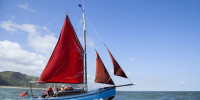
The Cheapest, Smallest Boat to Sail Around the World
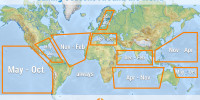
The Sailing Seasons Around the World (with Map)

Do You Need a License to Sail Around the World?
Own your first boat within a year on any budget.
A sailboat doesn't have to be expensive if you know what you're doing. If you want to learn how to make your sailing dream reality within a year, leave your email and I'll send you free updates . I don't like spam - I will only send helpful content.
Ready to Own Your First Boat?
Just tell us the best email address to send your tips to:

Best Sailboats For Families

Last Updated by
Daniel Wade
December 28, 2023
Sailing has always been a family activity and a great way for families to bond. But what sailboats are best (and safest) for the whole family?
Family sailboats are spacious, easy to sail, heel gently, and safe in rough weather. The best production family sailboats are the Catalina 22, the Catalina 30, the Lagoon 470 catamaran, and the Beneteau 49.
In this article, we’ll cover in-depth four of the best sailboats for family cruising. We’ll go over what to look for when choosing a family sailboat, along with what to avoid. Additionally, we’ll compare single and multihull designs and cover the benefits and drawbacks of each.
We sourced the information in this article from the sailing community and specifically sailing families who’ve embarked on extended voyages.
Table of contents
Family Sailboat Sailing Characteristics
Beyond obvious considerations (such as size and accommodations), what is the most important aspect of a family sailboat? It’s sailing characteristics—and this is especially true for monohulls. Sailing characteristics play a large part in the safety of the vessel and also the comfort of its less experienced crew.
There are several factors that contribute to sailing characteristics and a family-friendly boat. First and foremost, a boat’s heeling tendencies should be taken into consideration. Boxier modern boats tend to heel (lean over under sail) much less dramatically than older, more rounded designs. This is also true for wider boats, which are more stable.
Heeling is natural under sail, but it can be alarming to kids and inexperienced sailors. Additionally, it makes it much more difficult to cook or move around the boat safely—especially out on the deck but also in the cabin. A boat with milder handling is much better suited to families.
Another factor to consider is seakeeping. A comfortable boat is one that doesn’t pound excessively and takes waves gracefully—and this is not always the case. Some sailboats (particularly narrow and flat-bottomed versions) are notorious for being dreadfully uncomfortable in rough weather.
Larger, wider, and more rounded hulls handle waves much better than flat-bottom boats, though other factors also contribute to seakeeping abilities. The best family boats are a bit sluggish due to their increased displacement but far more comfortable when the weather gets rough.
Family Sailboat Size
What’s the ideal size for a family sailboat? Well, the answer clearly depends on the size of your family—however, we can start with a simple rule that a family sailboat should be able to accommodate at least four people comfortably.
Four people should be able to be in the same place at the same time—for example, in the cockpit or in a common area in the cabin. Some sailboats may accommodate six or more people in the cockpit, but only two or four around the dining table—which is not the ideal arrangement for a family.
The average size of a family sailboat is between 30 and 40 feet. This applies to both monohull and multihull sailboats. Sailboats of this size generally have standing headroom and enough sleeping spaces for the whole family. Additionally, virtually all sailboats of the size have a shower and toilet, and sometimes two.
Monohull Vs Multihull Family Sailboats
Monohull sailboats are vessels with a single hull. Monohulls are probably what you think of when you picture a typical sailboat. Multihull sailboats have multiple hulls, and the most common types are two-hull catamarans and three-hull trimarans.
Monohull sailboats are significantly less expensive than multihull sailboats. This makes them the most common choice for families who are more budget-sensitive when it comes to recreational equipment.
But when it comes to handling and cabin comfort, the multihull has several distinct advantages over the monohull. These sailboats distribute the force of the wind between multiple hulls and a wide stance, which makes them extremely safe and stable.
Additionally, virtually all cruising catamarans and trimarans have extensive center cabin space and several private stateroom areas in the hull. This allows families to give each person adequate space on long voyages. Many cruising families opt for a multihull, as the additional space is paramount to long-term comfort.
Best Family Sailboat Models
Hundreds of sailboat designs have been sold over the years, and a few stand out as spectacular family coastal cruising and long-distance sailboats. This list will include an example of each common family sailboat type, and we’ll specify the best uses for each vessel. Here are four of the best and safest family sailboats on the market today.
1. Catalina 22 Trailer Sailboat
{{boat-info="/boats/catalina-22"}}
The Catalina 22 is one of the most popular sailboats of all time. It was introduced in the 1960s as a family sailboat for lakes and coastal waters, and it was produced in many variations over the years. Thousands of Catalina 22 sailboats are still on the market today, which serves as a testament to their robust design and timeless utility.
Most Catalina 22 sailboats are trailerable, which means you don’t need to rent a permanent slip to store it. The vessel is 22 feet in length and can be towed by a reasonably sized SUV or standard pickup truck. It’s constructed with marine fiberglass, which is low maintenance and extremely durable.
The Catalina 22 is not designed for extended cruising. Instead, it’s a day boat with a reasonably sized cabin for short overnight trips. It is a perfect alternative to camping, and there’s usually enough space to sleep four.
All things considered, the cabin space aboard a Catalina 22 is generous. Some versions of the boat came with a pop-up companionway hatch, which turned sitting headroom into standing headroom towards the aft end of the cabin. This is exceedingly rare on small trailer sailers, and it’s a big perk of having a Catalina 22.
The Catalina 22 is the perfect starter boat for a family. It’s heavy and stable and offers excellent sailing characteristics (even in higher winds). Additionally, it’s easy to rig and small enough to be handled by one or two people. Kids can learn the basics of sailing and get experience piloting a “big” boat—at least when compared to a dinghy or a Sunfish.
The Catalina 22 can be found on the used market for between $5,000 and $15,000. Outliers exist, and you may be lucky enough to find a Catalina 22 in operable condition for less than $3000–trailer included.
2. Catalina 30 Cruising Sailboat
{{boat-info="/boats/catalina-30"}}
Catalina makes the list again with its extremely popular 30-foot sailboat. The Catalina 30 is a fiberglass sloop that was introduced around the same time as the Catalina 22. Unlike the Catalina 22, the Catalina 30 is more than capable of open ocean sailing—but it’s also easy to handle on short trips in coastal waters.
Catalina 30 sailboats have a wide beam which makes them stable under heavy sail and in rough water. They also have a high freeboard, which keeps the cockpit relatively dry and prevents excessive spray over the bow. These characteristics also minimize heeling, which makes it a comfortable boat for inexperienced sailors.
The cabin is another huge selling point of the Catalina 30. These vessels have standing headroom throughout, along with enough sleeping space for six adults or more. Additionally, the Catalina 30 features a full kitchen (or galley) along with a sitting area and table that’s large enough for the entire family to sit down for dinner.
This vessel is more complex than the Catalina 22. However, anybody who can handle a Bermuda-rigged sailboat that’s larger than 20 feet can easily transition to a Catalina 30. Like the 22-foot model, this sailboat was produced in great numbers during the 20th century, and hundreds are available on the used market in excellent condition.
The Catalina 30 is ideal for a family who wants to take an occasional bluewater voyage. A trip between Florida and the Bahamas is well within the capabilities of the sailboat, and more adventurous sailors frequently sail it between San Francisco and Hawaii.
It’s also a great day boat for coast cruising, as it absorbs bad weather better than smaller boats and handles surprisingly well in low winds.
3. Lagoon 470 Cruising Catamaran
{{boat-info="/boats/lagoon-470"}}
Do you have a large family, or do you place a premium on space and comfort for long-distance sailing? If so, the Lagoon 470 could be your best option. It’s a large, 47-foot cruising catamaran that offers better speed and stability than any similarly-sized monohull.
The Lagoon 470 is a typical catamaran in many respects—it has a large center cockpit area that’s covered and features communal spaces such as the galley and a large sitting area. This space alone is wider than most monohull cabins and offers the family a great place to hang out.
Below decks in the hulls, the Lagoon 470 has several separate bedrooms and private bathroom/shower combinations. This gives family members their own space and reduces the risk of conflict when it comes to showering and sleeping.
Catamarans like the Lagoon 470 have many advantages but also a few drawbacks. This vessel is more difficult to operate in tight spaces and requires more docking space than a traditional monohull. That said, if you can manage the additional stress during docking, you’ll enjoy a much safer and more pleasant time on the water.
Due to its spectacular sailing characteristics and large size, the Lagoon 470 is best suited for long-haul sailing or full-time living. It’s definitely not a day boat—and its high price makes it an unreasonable choice of occasional sailing.
If you want to travel the world with your family, this is the boat for you. If you’re cruising around the bay on the weekends, you may want to consider something like the Catalina 30.
4. Beneteau 49 Bluewater Monohull Sailboat
{{boat-info="/boats/beneteau-49"}}
Here’s an exceptional monohull that stacks up with the best multihulls in terms of space, comfort, and seaworthiness. The Beneteau 49 is nearly 50 feet long and provides accommodations fit for the largest families.
The Beneteau 49 is the quintessential cruising sailboat. It’s wide, fast, and agile—and it has handling characteristics that put it in line with the hardiest recreational sailboats. Plus, the cabin is modern and spacious and includes everything you need to spend weeks (or months) aboard comfortably.
Separate enclosed sleeping areas give each family member privacy, and a sense of ownership over their space—which many families affirm is key when living in tight quarters. Plus, it’s a recent Beneteau design, which means it comes equipped with the latest technology and amenities.
Many of the more difficult aspects of rigging and sailboat control are automated on the Beneteau 49, meaning you can control them from the cockpit without sending anyone out on deck. This keeps the family safe and comfortable in foul weather and reduces the grunt work associated with sailing.
And when it comes to safety, it’s hard to beat a big hardy monohull like the Beneteau 49. This vessel has a wide stance and a semi-flush deck, meaning it’s well-balanced and designed to take on the toughest weather conditions. Additionally, its extended length increases hull speed, reducing the time it takes to get between stops.
As far as price is concerned, you’ll probably pay about the same for a Beneteau 49 as you would for a mid-ranged multihull. This can easily enter the $100,000+ price point, which is steep—but worth it if you and your family intend to live aboard and do extended cruising.
Related Articles
Best Sailboats For Lakes
10 Best Sailboats To Live In
Best Trailerable Sailboats Under 30 Feet
I've personally had thousands of questions about sailing and sailboats over the years. As I learn and experience sailing, and the community, I share the answers that work and make sense to me, here on Life of Sailing.
by this author
Best Sailboats
Most Recent

What Does "Sailing By The Lee" Mean?
October 3, 2023

The Best Sailing Schools And Programs: Reviews & Ratings
September 26, 2023
Important Legal Info
Lifeofsailing.com is a participant in the Amazon Services LLC Associates Program, an affiliate advertising program designed to provide a means for sites to earn advertising fees by advertising and linking to Amazon. This site also participates in other affiliate programs and is compensated for referring traffic and business to these companies.
Similar Posts

Affordable Sailboats You Can Build at Home
September 13, 2023

Best Small Sailboats With Standing Headroom

Best Bluewater Sailboats Under $50K
Popular posts.

Best Liveaboard Catamaran Sailboats

Can a Novice Sail Around the World?
Elizabeth O'Malley
June 15, 2022

4 Best Electric Outboard Motors

How Long Did It Take The Vikings To Sail To England?

10 Best Sailboat Brands (And Why)
December 20, 2023

7 Best Places To Liveaboard A Sailboat
Get the best sailing content.
Top Rated Posts
Lifeofsailing.com is a participant in the Amazon Services LLC Associates Program, an affiliate advertising program designed to provide a means for sites to earn advertising fees by advertising and linking to Amazon. This site also participates in other affiliate programs and is compensated for referring traffic and business to these companies. (866) 342-SAIL
© 2024 Life of Sailing Email: [email protected] Address: 11816 Inwood Rd #3024 Dallas, TX 75244 Disclaimer Privacy Policy

The Best New Small-Ship Cruises to Book in 2024
A uthentic. It was Merriam Webster's top searched word for 2023 and one that has dominated the travel vernacular in recent years. And while many would not necessarily associate the word with ocean cruising , the growth in popularity of small-ship cruises-particularly sailings with 500 guests or fewer-indicates that in the cruising world, passengers are seeking a more intimate, less crowded, and yes, arguably more authentic sailing experience.
Take expedition cruising , for example. As the number of adventure-focused ships and yachts has exploded in recent years, these cruises are no longer just about extreme voyages in polar regions. They are also about offering a deeper look into the culture, food, history, and environmental fragility of remote wonders of the world.
Although there isn't a huge number of new small ships being introduced, there are a few notable vessels that have either recently launched or are launching this year with a focus on the idea that smaller is not just better, but more sustainable, too. These new small-ship cruises bring with them some exciting and more immersive new itineraries to destinations both warm and wintry that have us ready to pack our bags and sail away.
Sea Cloud Cruises' "Sea Cloud Spirit"
- Suggested itinerary: Reset your mind and body on an eight-night sailing through Spain's Canary Islands and on to Morocco on a special cruise featuring experts in restorative health. Pricing starts at $4,895 per person.
What's more authentic-and sustainable-than setting sail on a tall ship where the sails are hoisted up each day by hand? Although not technically new (it was launched in 2021), the 136-passenger Sea Cloud Spirit and its two sister ships, Sea Cloud and Sea Cloud II , are upping their game in a push to introduce Sea Cloud Cruises' unique product to North American travelers. The German company has traditionally catered to German and British passengers. As part of its effort to expand its reach and appeal, Sea Cloud is adding wellness programs with daily onboard yoga and guest fitness gurus, in addition to special food- and wine-focused sailings with well-known chefs making appearances. Sea Cloud Spirit , the largest of the three-ship fleet with 69 cabins, was meticulously designed to pay homage to the original Sea Cloud , which was the world's largest private sailing yacht when Wall Street broker Edward Francis Hutton had it built in 1931 for his wife, Marjorie Merriweather Post.
The Sea Cloud Spirit combines the experience of decades of traditional seamanship with the modern-day luxuries of a private yacht. Cabins range from 172-square-foot single cabins to 300-square-foot balcony suites with soaking tubs. There's a large fitness center and spa, which has a steam room, sauna, and thermal area for two; indoor and outdoor lounges; and a main dining area, plus a more casual bistro. The action, however, is out on deck, where passengers can stargaze at night or simply gaze in awe at the impressive sails blowing in the wind.
Atlas Ocean Voyages' "World Navigator"
- Suggested itinerary: Go searching for Arctic wildlife on a 12-night cruise from Reykjavík, which sails along the eastern coast of Greenland and to Longyearbyen in the Svalbard archipelago, one of the world's northernmost inhabited areas and home to polar bears, reindeer, arctic foxes, and other Nordic wildlife. Pricing starts at $6,499 per person.
World Navigator , which sailed its maiden voyage in Antarctica this past November, is the third vessel to join the fleet of one of the newest players in small-ship expedition cruising, Atlas Ocean Voyages. The company's 100-cabin expedition yachts are almost identical and provide a hybrid of sorts between traditional expedition and luxury cruising. Cabins are spacious, almost all with balconies, desks, and seating areas. The bathrooms have glass-mosaic tiled showers with rain showerheads, wall jets, and even benches.
Everything on the ship-including the sauna with floor-to-ceiling windows-is designed to provide maximum views. The ships also have spacious pool decks with two hot tubs, a fitness center overlooking the sea, a spa, and water toys like kayaks and paddleboards. There's even extreme camping gear for those willing to brave an overnight under the stars in Antarctica. During North American winters, all three of Atlas's expedition yachts sail in Antarctica. With the addition of World Navigator , the company is launching more Arctic Circle cruises during the North American summers while also adding a host of new epicurean and cultural expeditions in South America, the Caribbean, the Mediterranean, and northern Europe this year.
Ritz-Carlton Yacht Collection's "Ilma"
- Suggested itinerary: Spend a little extra time in port on a 10-day sailing from Barcelona to Lisbon, which has three overnight stays, in Palma de Mallorca and Malaga in Spain, and in Lisbon, Portugal, one of Europe's oldest cities. Pricing starts at $10,600 per person.
Another newcomer to luxury small-ship cruising is the Ritz-Carlton Yacht Collection, which debuts its second ship, the Ilma , this year. With 224 suites, the ship is larger than the original Ritz-Carlton yacht, the 149-suite Evrima , which launched in October 2022. On the Ilma , all the suites will have private terraces, including a two-story suite with soaking tub; the coveted, 1,000-square-foot owner's suite has a private outdoor whirlpool. Even the smallest suites are not all that small, at 300 square feet, and come with a personal concierge and 24-hour room service. The yacht boasts what Ritz-Carlton says is the highest ratio of space per guest at sea.
And you can expect to find the same meticulous service standards that you would find at Ritz-Carlton resorts throughout the world as the line aims to impress hotel guests seeking a luxury hotel experience at sea. Onboard are five dining venues, including S.E.A., a European tasting experience designed by chef Sven Elverfeld of Aqua, the three Michelin-starred restaurant at the Ritz-Carlton in Wolfsburg, Germany; Talaat Nam, featuring Southeast Asian cuisine and a sushi bar; and Mistral, a casual come-as-you-are alfresco grill with a Mediterranean-inspired menu. Light bites are served at the marina at the aft of the ship, where you can also hop on a borrowed paddleboard. Oh, and did we mention there are two outdoor pools, too?

6 ultimate island-hopping itineraries for 2024
Explore the world from the deck of your own yacht with a skippered charter, bareboat or flotilla holiday. Whether you’re a first-timer, a foodie or a family, there’s a sailing itinerary to suit every type of traveller.

Craving a holiday with the freedom to escape the crowds and explore hidden coves, secluded bays and uninhabited islands? Dreaming of anchoring somewhere to take a dip without another person in sight? Sailing enables you to access remote spots that are often inaccessible by land and to experience the diversity of a region, exploring islands, villages and resorts in a single trip. Whether you're just starting out, or keen to set out with little ones in tow, these itineraries suit every type of sailor.
1. Best for first timers: British Virgin Islands (BVIs)
Calm seas, sheltered anchorages, reliable steady trade winds and easy line-of-sight sailing make the BVIs one of the world’s best sailing destinations for less experienced sailors. The proximity of its islands also means you only need to sail for an hour or two to gain a sense of adventure and achievement as you successfully navigate to the next port of call. Set sail in Tortola and continue on to Virgin Gorda to witness The Baths, a geological wonder made up of granite boulders that stretch down the beach into the sea. Look out for hawksbill turtles as you sail on to tiny specks of land such as the idyllic Saba Rock, and be sure to end the day with a rum cocktail or two at one of the region’s many laid-back bars, which are often perched on unblemished stretches of white sand.

2. Best for families: Croatia
The calm, clear waters of the Adriatic combined with favourable weather conditions in summer provide easy sailing for families and, with more than 1,000 islands dotted along the Dalmatian Coast, there’s a range of activities and attractions with short hops to keep kids engaged. Set sail from the picturesque marina village of Agana and cruise gently to islands such as Brač, Šolta and Hvar, encouraging children to help out on board while keeping an eye out for passing dolphins. With their sheltered bays and clear waters, these islands are ideal stops for families. Spend an afternoon paddling in Brač’s Bobovišća Bay, before setting sail for the remote islands of the Kornati Archipelago, a wild and beautiful national park known for its empty hiking trails. Sailing stops here can be educational, too, with a plethora of UNESCO World Heritage Sites and picturesque port towns steeped in history.
3. Best for food-lovers: Italy
Why base yourself on land to sample Italy’s incredible gastronomy when you can sail from region to region tasting the very best food and wine at numerous ports of call? Sunsail’s SailEatalia’s Italian Cuisine Procida Flotilla departs from the glamourous port town of Procida and sails to the Pontine Islands along the sun-soaked Amalfi Coast, offering stops to taste local cuisine, from classic dishes to regional delicacies as well as the country’s finest wine. Sample Ischia's iconic stewed rabbit in an independent restaurant at the top of a mountain or try the Italian coastal delicacy alici da portare (pasta with anchovies, olives and capers) in the quaint fishing village of Cetara.

4. Best for winter sun: Antigua
Gloriously warm weather between December and May and around 365 powdery white beaches lapped by clear waters make Antigua a popular winter sun destination for British travellers. Sailors can also relax knowing the region has consistent trade winds, safe anchorages and fairly short distances between ports, giving you more time to explore a variety of attractions at your own pace. Drop anchor in Deep Bay to snorkel around the famous shipwreck the Andes , discover uninhabited islands and visit famous places like Nelson’s Dockyard to sip cocktails and dance to the lively music of traditional steel bands.
5. Best for culture vultures: Croatia
A cultural treasure trove with 10 UNESCO World Heritage Sites ranging from Roman fortresses to hilltop castles, Croatia is a mecca for sailors with a penchant for history and art. Start and finish a week’s charter in Dubrovnik to explore one of the best-preserved medieval walled cities on Earth, touring ancient citadels and Renaissance palaces, and be sure to include Lokrum, home to the ruins of a Benedictine monastery. Sail north and discover Mljet National Park and the island getaway of Korčula, thought to be the birthplace of famed explorer Marco Polo, where museums, galleries and excellent restaurants line the beautiful cobbled streets and defensive walls of the town.
6. Best for island-hopping: Greece
With thousands of islands scattered fairly close together, sailing from one to another is a breeze with the promise of a remote white sand or perfect pebble beach around every headland. Sailors are spoilt for choice, but the Ionian Islands, off the west coast of the mainland, are ideal for beginners looking for tranquil stretches of gin-clear water with light winds and warm temperatures in summer. Sail to Ithaca or Kefaloni in the south or to Lefkas, Paxos, Antipaxos and Corfu. While Corfu is known for its party vibe and high-end beach bars, others, like tiny Antipaxos, feature just a scattering of houses, no proper roads and a couple of charming waterside tavernas where you can watch local fishermen bring in the day's catch.
Related Topics
- BEACH ACTIVITIES
You May Also Like

How to plan the ultimate island-hopping adventure in the Philippines

A Caribbean island-hopping adventure in St Vincent & the Grenadines

A guide to island-hopping in the Seychelles

Find secluded Greek island coves on a beach-hopping boat tour of pint-sized Paxos

A break in Llandudno, a vintage Welsh beachside resort with enduring appeal
- Terms of Use
- Privacy Policy
- Your US State Privacy Rights
- Children's Online Privacy Policy
- Interest-Based Ads
- About Nielsen Measurement
- Do Not Sell or Share My Personal Information
- Nat Geo Home
- Attend a Live Event
- Book a Trip
- Inspire Your Kids
- Shop Nat Geo
- Visit the D.C. Museum
- Learn About Our Impact
- Support Our Mission
- Advertise With Us
- Customer Service
- Renew Subscription
- Manage Your Subscription
- Work at Nat Geo
- Sign Up for Our Newsletters
- Contribute to Protect the Planet
Copyright © 1996-2015 National Geographic Society Copyright © 2015-2024 National Geographic Partners, LLC. All rights reserved
Baltimore Port: What impact will bridge collapse have on shipping?

PORT FEATURES
Current status of cargo ships inside port, cruise ships, london metal exchange warehouses, bunker fuel.
Get weekly news and analysis on the U.S. elections and how it matters to the world with the newsletter On the Campaign Trail. Sign up here.
Reporting by Josephine Mason, Nick Carey, Helen Reid, Jonathan Saul, Nigel Hunt, Marwa Rashad, Scott DiSavino, Shariq Khan and Eric Onstad; Compiled by Josephine Mason and Nina Chestney; Editing by Nick Macfie and Nick Zieminski
Our Standards: The Thomson Reuters Trust Principles. , opens new tab

Ultra-Orthodox Israelis resist push for military service
Ultra-Orthodox Jewish parties are resisting pressure to lift exemptions of religious students from military duty, as Prime Minister Benjamin Netanyahu struggles to preserve his coalition and spread the wartime burden across society fairly.

The Italian airforce said on Friday it intercepted unidentified aircraft flying over international waters in the Baltic Sea, and two defence sources in Rome identified them as Russian planes.


IMAGES
VIDEO
COMMENTS
Vancouver 28. Photo credit: YachtFathom.co.uk. A sensible small boat with a "go-anywhere" attitude, this pocket cruiser was designed with ocean sailors in mind. One of the best cruising sailboats under 40 feet, the Vancouver 28 is great sailing in a small package. Hull Type:Full keel with transom hung rudder.
The most appropriate small and cheap boat to sail around the world is the Hurley 22. At around $3,000 it is a lot of boat for the money. Fully equipped as a liveaboard for a couple, it is seaworthy enough to cross oceans. ... But as hinted in our article 'How Big Should a Sailboat Be to Sail Around the World', size doesn't really matter that ...
Skipper Matt Kent was working on a 200ft tall ship when he pondered what the smallest boat ever to sail around the world had been. On discovering that a 5ft 4in yacht had crossed the Atlantic, a ...
5. Beneteau 57. feelthebreezefamily. This is possibly one of the best, high-end options on the market currently! The Beneteau 57 is designed to be as stylish and reliable as possible. It would be fair to categorise it as a luxury cruiser that's for sure! The hull is designed to be as fast and as sleek as possible.
73-year-old man plans to sail around world in world's smallest boat At 3meters-long, the vessel is only slightly bigger than a bathtub World renowned boat builder Sven Yrvind says creation is ...
Catalina 16.5. jlodrummer. Catalina Yachts are synonymous with bigger boats but they have some great and smaller boats too such as Catalina 16.5. This is one of the best small sailboats that are ideal for family outings given that it has a big and roomy cockpit, as well as a large storage locker.
Nicholson 35. Now somewhat legendary, the tough and dependable Nicholson 35 first appeared in 1971, and between then and 1985, some 228 boats were launched. Built to Lloyds' specifications with a hand-laid solid GRP hull, she boasts a fully encapsulated lead fin keel and full-depth skeg. She has an alluring sheer with nicely balanced ...
Szymon, who set sail last year from Plymouth on August 19, completed the circumnavigation in 270 days, 10 hours and 29 minute. The World Sailing Speed Record Council recognizes a similar feat by Alessandro di Benedetto (FRA/ITA) in 2009-10 who sailed a 6.5m (21ft 3.9in) Mini yacht around the world in 268 days, 19 hours, 36 minutes, 12 seconds.
At 74 years old, Sven Yrvind wants to save the world. When I ask him how he plans to do it, his answer is simple: circumnavigate in a ten-foot sailboat. If—or rather, according to Sven, when —he accomplishes this, he will have skippered the smallest boat to circle the world. "I want to show people that we can live in a small space and ...
That's a new world record for the smallest yacht to circumnavigate the globe non-stop with no engine. For perspective, less than 300 people are known to have sailed single-handed around the world — only 80 have done so without stopovers or assistance. The sailboat, a Maxus 22, was manufactured in the Northman shipyard in Poland.
Let's get this out of the way first - you don't need a large boat to circumnavigate the world. Larger boats are comfier and faster, but technically not necessary. The smallest sailboat to circle the globe had around 21 feet. We have written many times about small boats that are great liveaboards, so it is possible.
2. Island Packet 349. The Island Packet 349 was crowned by the Cruising World as the 'Best Midsize Cruiser Under 38 Feet.' [] It provides passengers safe and comfortable long-haul sailing and cruising despite bad weather conditions.. The IP 349 is designed as a two-cabin boat wherein the single head offers a separate shower compartment that is unique to boats under 38 ft.
August 30, 2022. Catamarans are generally longer than monohulls, but their accommodations and handling vary widely between sizes. The best size catamaran to sail around the world is 45 to 50 feet. The smallest catamaran with space for long-term provisions and a cabin is around 30 feet in length, and a 55 to 60-foot catamaran is the largest that ...
In 1987, Serge Testa beat that by sailing round the world in his self-designed 11ft 10in (3.6m) aluminium sloop, Acrohc Australis.He broke the record for the smallest yacht to be sailed round the ...
Choosing the right boat to take you across an ocean or around the world can be confusing and exasperating, particularly with a tight budget. Vigor sets out to remedy that in this book. He compares the designs and handling characteristics of 20 different boats whose secondhand market prices start at about $3,000.
The Pardeys are icons of small sailboat cruising. Having sailed over 200,000 nautical miles and circumnavigated both east and westbound on their home-built, engine-free, sub-30-feet cutters, they are among the most recognized sailors in the world. They're also known as "America's first couple of cruising.".
Navigating the World: Choosing the Right Size Boat for Your Round-the-World Sailing Adventure. 01/10/2023. Circumnavigating the globe is not a goal for the faint of heart, and it takes a lot of planning. One of the earliest decisions to make is the boat to choose, and how big it should be. "Navigating the World: Choosing the Right Size Boat ...
Introduced in 2003, the Hanse 371 is a mid-sized boat that was designed in a true blend of old and new boating technology. Thanks to its furling and self- tacking jib, the Hanse 371 becomes an instant single-handed sailing vessel that takes much of the strain out of your solo sailing adventures.
The Fast Route - for the minimum time. The Pleasure Route - for the maximal pleasure. The Traditional Route - the road most taken. The Arctic Route - for the rough ones. The Dangerous Route - without regards for piracy. The Cheap Route - with a budget in mind. The Coast Lover's Route - never going far from the coast.
A sandbar in the middle of nowhere. 1. Get some offshore sailing experience. Sure sailing around the world sounds romantic—the freedom of the open ocean, sunsets on a beach in Bora Bora, sipping fresh water from a coconut you picked yourself (words of caution: climbing a palm is much harder than it looks!).
The best sailboat size to sail around the world is 35 to 45 feet. Smaller boats of 25 feet will be more uncomfortable and inconvenient; it is, however, possible. Larger sailboats of 60 foot and up will be more comfortable, but they are more expensive as well. Read on, we will have a look at these statements more closely; a cookie-cutter ...
Best Small Sailboats With Standing Headroom. Daniel Wade. December 28, 2023. Best Bluewater Sailboats Under $50K. Daniel Wade. December 28, 2023. Popular Posts. Best Liveaboard Catamaran Sailboats. Daniel Wade. December 28, 2023. Can a Novice Sail Around the World? Elizabeth O'Malley. June 15, 2022. 4 Best Electric Outboard Motors. Daniel Wade ...
Picking out a great vessel is imperative to enjoying a great sailing experience. We have selected the creme de la creme of sailboats suitable for a range of budgets and needs. Jeanneau Sun Odyssey 380. Beneteau First 44. Fountaine Pajot Isla 40. Hylas 57. Leopard 42.
Sea Cloud Spirit, the largest of the three-ship fleet with 69 cabins, was meticulously designed to pay homage to the original Sea Cloud, which was the world's largest private sailing yacht when ...
Explore the world from the deck of your own yacht with a skippered charter, bareboat or flotilla holiday. Whether you're a first-timer, a foodie or a family, there's a sailing itinerary to ...
More than 40 ships remained inside Baltimore port, including small cargo ships, tug boats and pleasure craft, data from ship tracking and maritime analytics provider MarineTraffic shows.